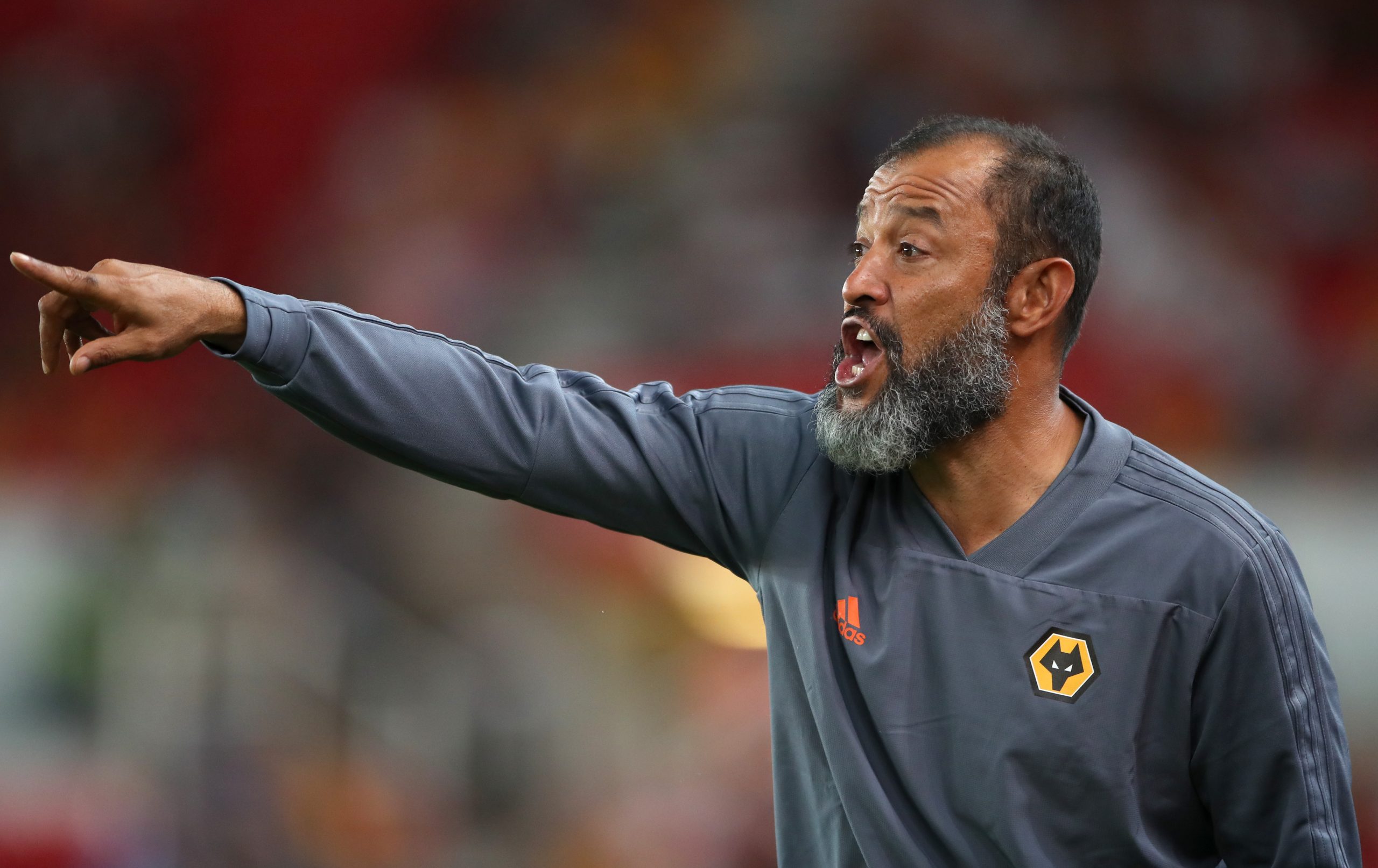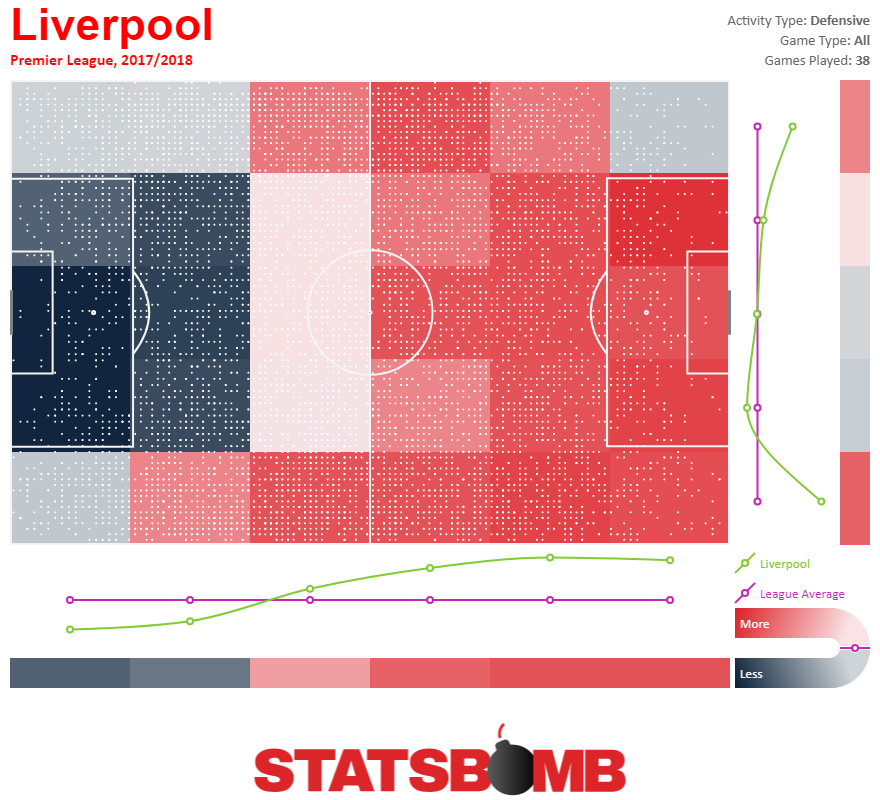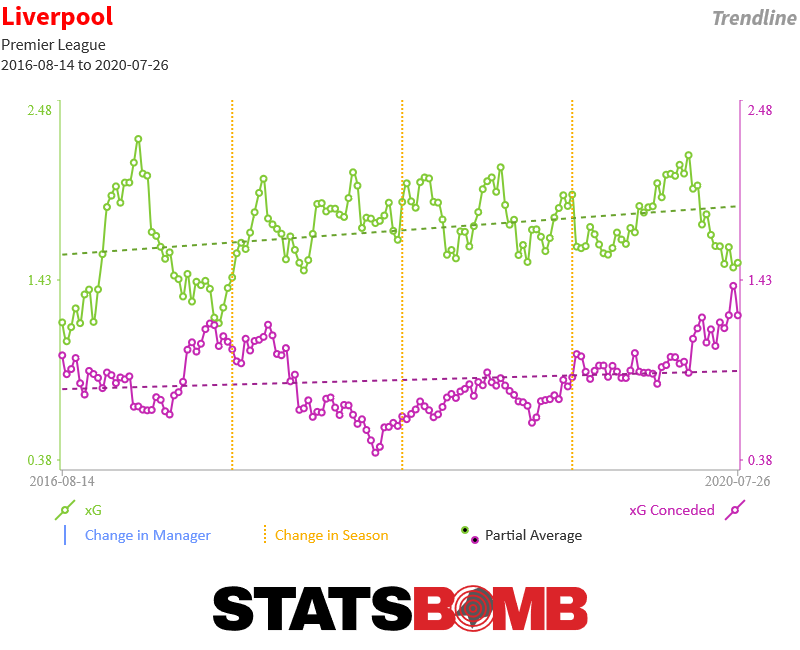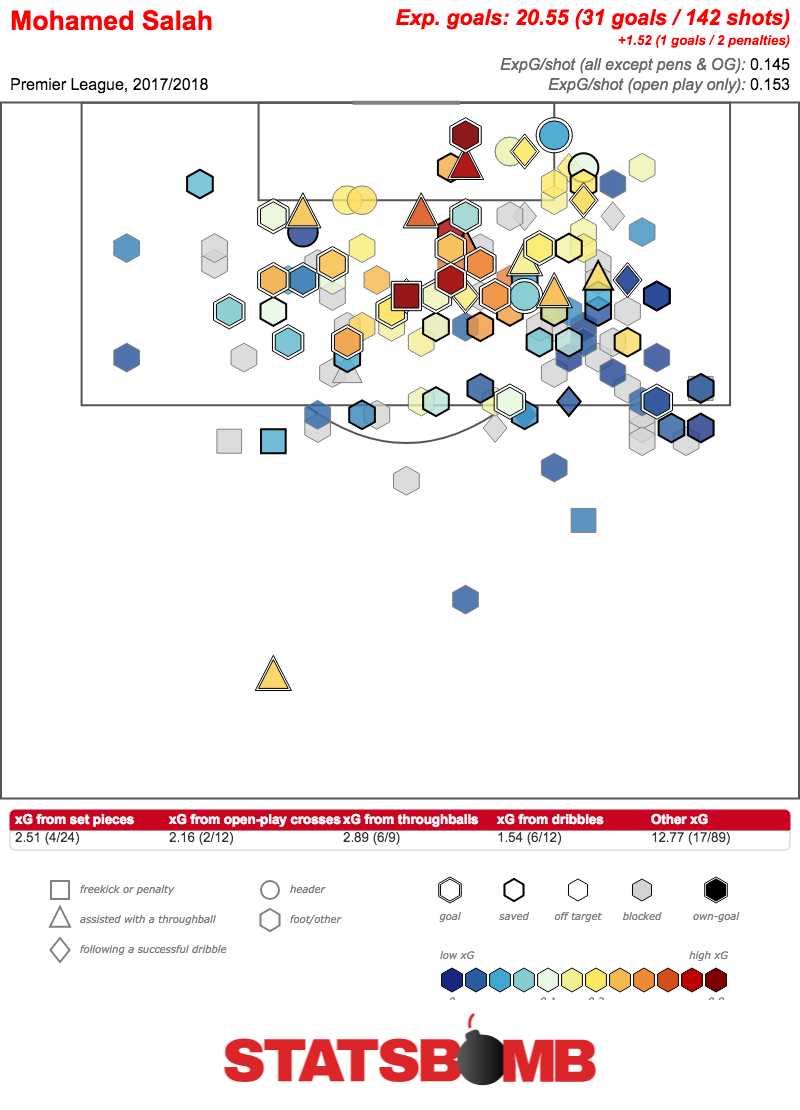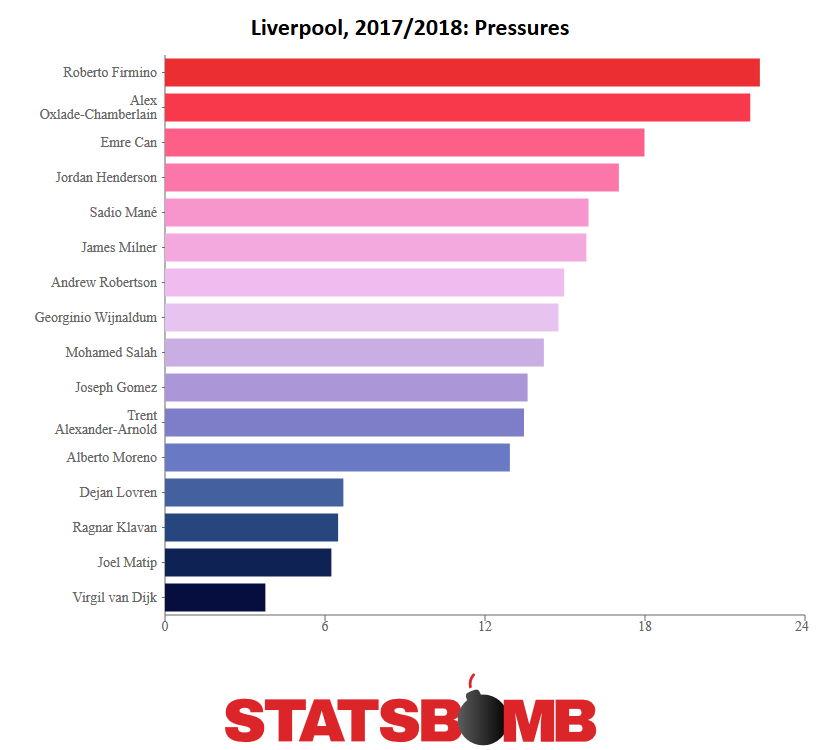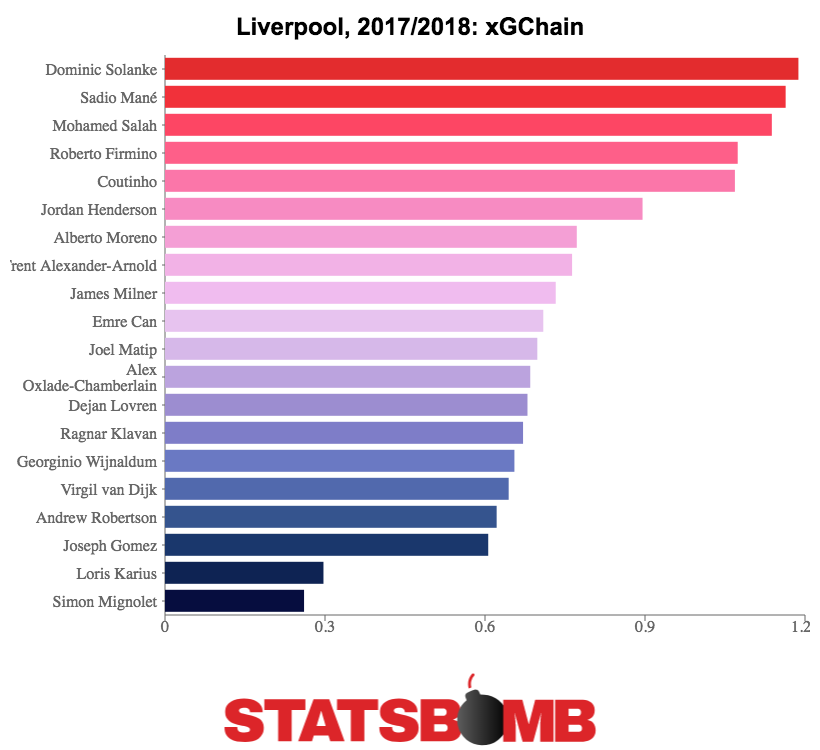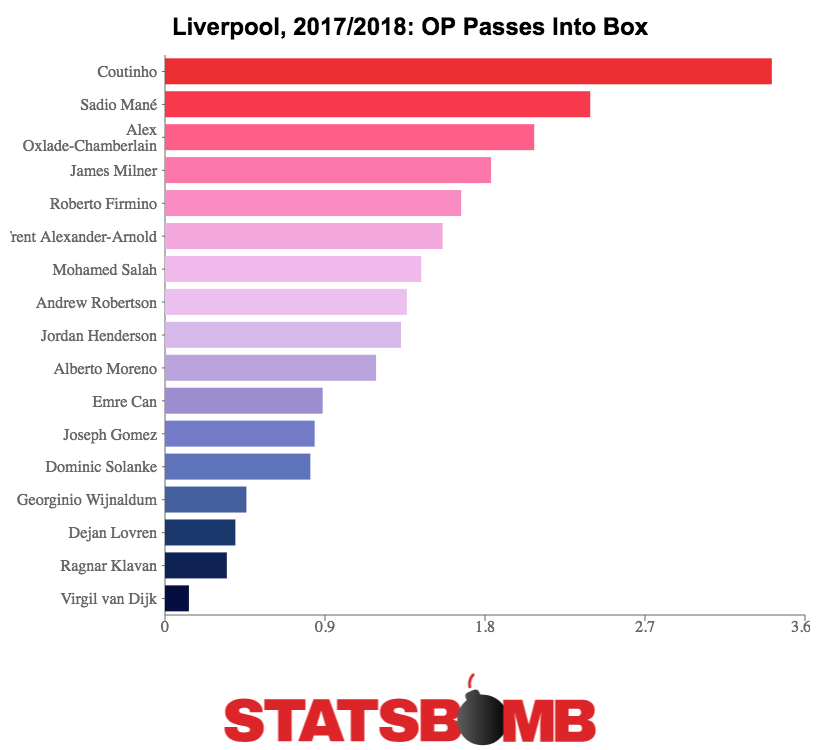Newcastle United are moored between optimism and pessimism. On the pitch there’s an OK enough squad, marshalled by an organiser of high repute in Rafael Benítez, a manager who has been embraced by supporters in a way no Newcastle gaffer has been for a long time. A 10th placed finish last season right after achieving promotion? Not too shabby. Off the pitch, though, is the ever-lurking Mike Ashley. An owner who is seen as the impediment to all that brewing positivity. Despite the reasons to be cheerful, there's always some tension boiling under the surface at St James' Park. Last season was a decent old job for a newly promoted side, even if it won't win any awards for entertainment value. Come against Benítez’ boys and you’ll be faced with a deep/mid, compact 4-4-1-1 / 4-4-2. Other formations are sprinkled in on occasion, yet the principles remain the same. A gigantic wall blocking the way. Only engaging with any real intensity as the ball spreads out wide, edges closer to their goal or enters into a danger area. Sometimes the height of the press adjusts situationally. There’s an almost hypnotic aspect to watching that shape move back and forth, from side to side. 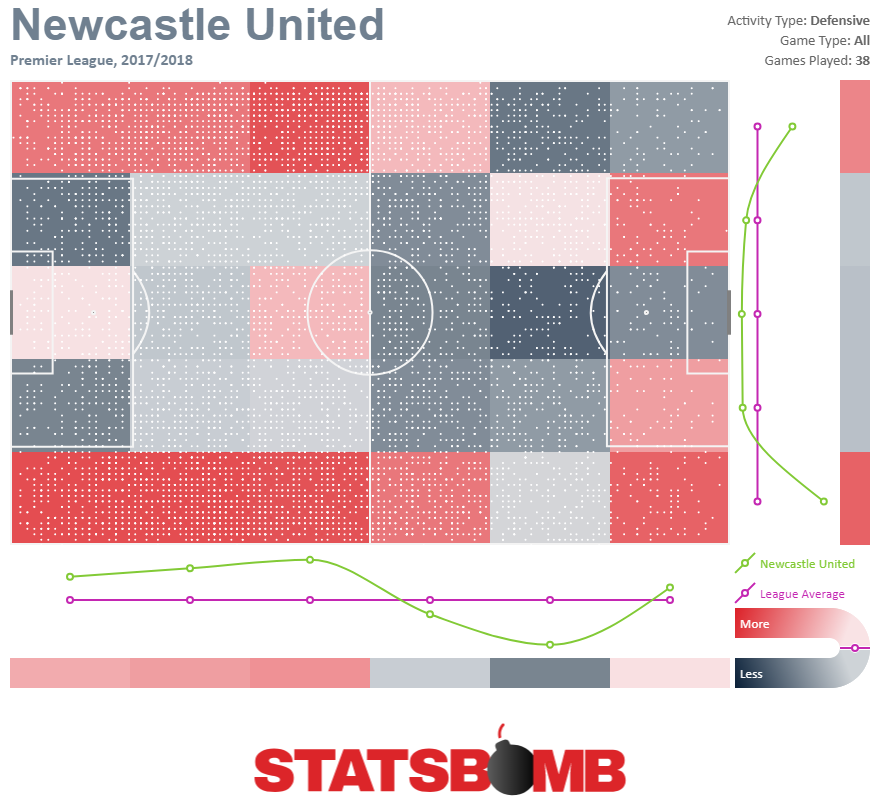 It’s likely that the impression most neutrals have of Newcastle in their mind is of this defensively astute team, with an impotent long ball attack. Yet their numbers don’t reflect this dichotomy. They ranked 11th in overall non-penalty expected goal difference last year, but came out 14th in non-pen xG conceded and 9th in non-pen xG created. If anything they were roughly equal on both sides of the ball in expectation. A dynamic that was obscured in actuality, as they underperformed their xG by about 7 goals - the largest such negative margin in the league - and overpeformed by a similarly large margin in defence.
It’s likely that the impression most neutrals have of Newcastle in their mind is of this defensively astute team, with an impotent long ball attack. Yet their numbers don’t reflect this dichotomy. They ranked 11th in overall non-penalty expected goal difference last year, but came out 14th in non-pen xG conceded and 9th in non-pen xG created. If anything they were roughly equal on both sides of the ball in expectation. A dynamic that was obscured in actuality, as they underperformed their xG by about 7 goals - the largest such negative margin in the league - and overpeformed by a similarly large margin in defence. 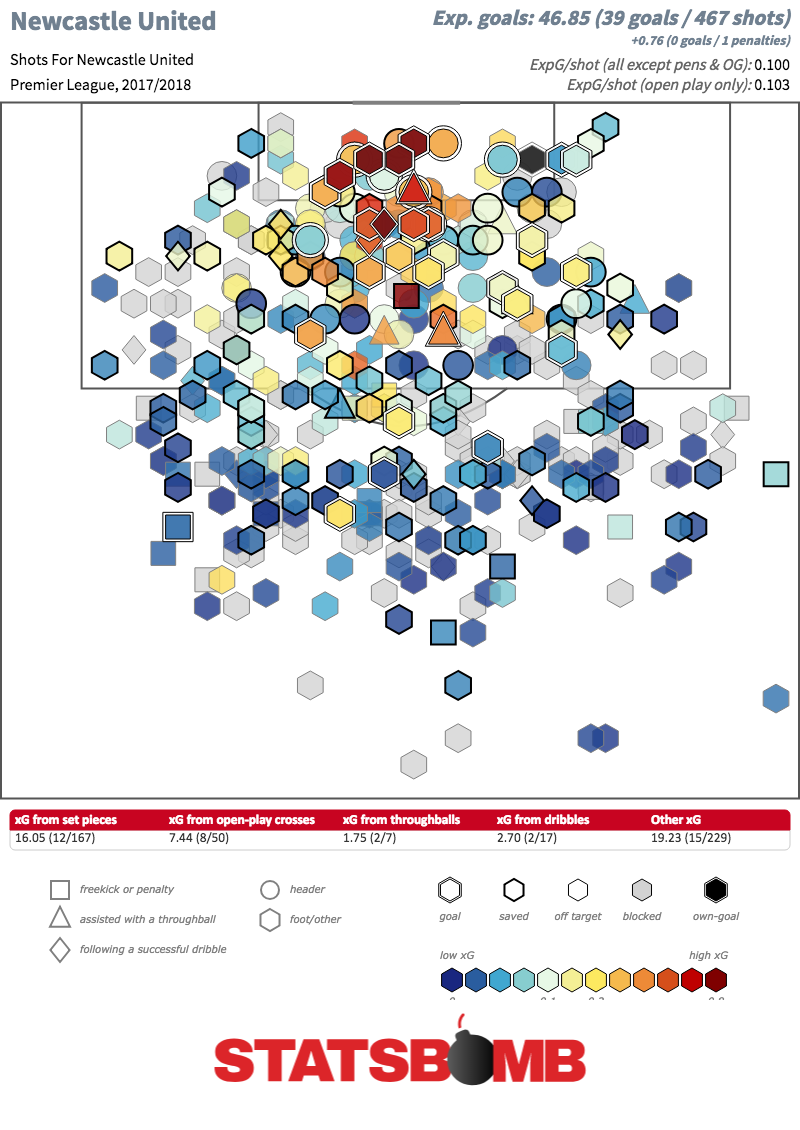
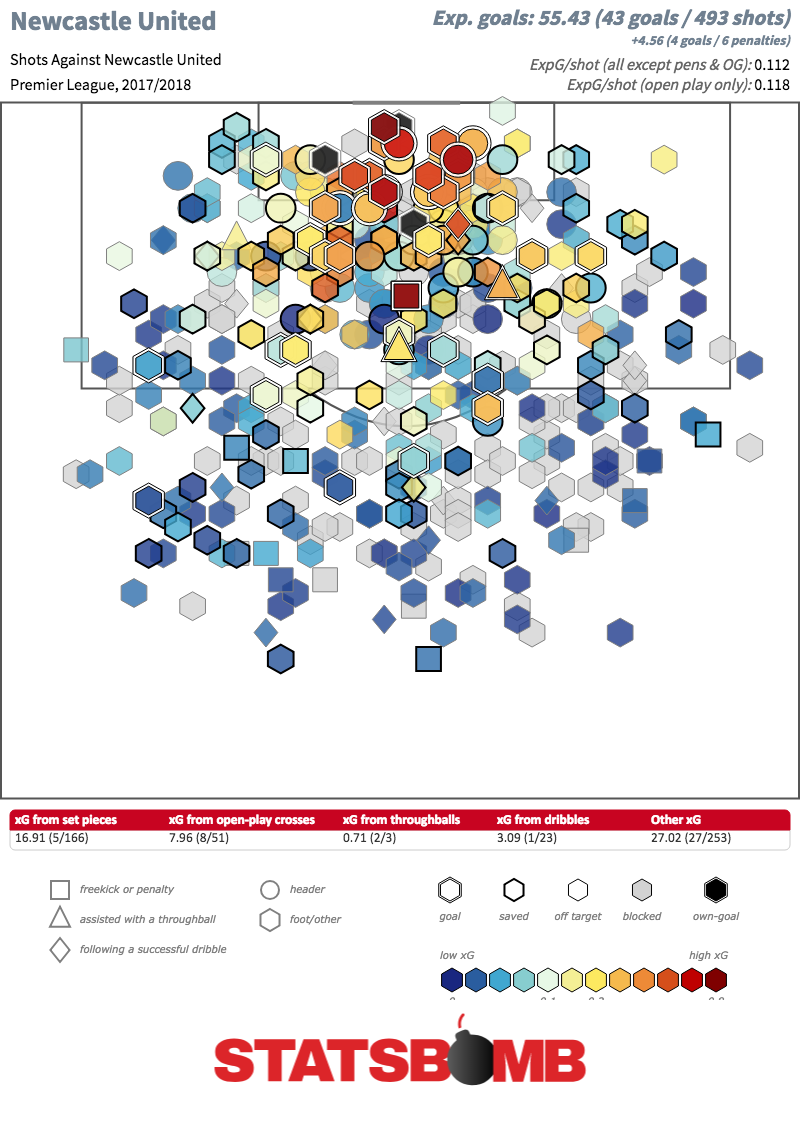 There was no single obvious stylistic weakness in their defensive game. In most regards - counter attacking shots conceded, in the clear shots conceded, conceding shots after losing the ball in their own half etc etc - they were midtable or around there. The classic recipe of being generally so-so and ending up, well, midtable. On the other end the surface numbers would suggest an unhealthy attack; their average shot distance is the furthest from goal in the league, and they complete the fourth fewest passes into the opposition box. This was mostly due to the weakness of their possession game. On possessions that featured 10 or more passes, Newcastle again had the poorest shot distance in the Premier League, as well as close to the worst xG created. This is evidently not where they make their money offensively. Given their defensive plan, you can probably imagine their main mode of attacking play: directness is the name of the game. They're one of the fastest teams in the league and play amongst the most long balls. This is how they make hay, how they end up grading out as a solid attack. They accumulated the fourth highest xG total from open play possessions that featured 5 or fewer passes.
There was no single obvious stylistic weakness in their defensive game. In most regards - counter attacking shots conceded, in the clear shots conceded, conceding shots after losing the ball in their own half etc etc - they were midtable or around there. The classic recipe of being generally so-so and ending up, well, midtable. On the other end the surface numbers would suggest an unhealthy attack; their average shot distance is the furthest from goal in the league, and they complete the fourth fewest passes into the opposition box. This was mostly due to the weakness of their possession game. On possessions that featured 10 or more passes, Newcastle again had the poorest shot distance in the Premier League, as well as close to the worst xG created. This is evidently not where they make their money offensively. Given their defensive plan, you can probably imagine their main mode of attacking play: directness is the name of the game. They're one of the fastest teams in the league and play amongst the most long balls. This is how they make hay, how they end up grading out as a solid attack. They accumulated the fourth highest xG total from open play possessions that featured 5 or fewer passes. 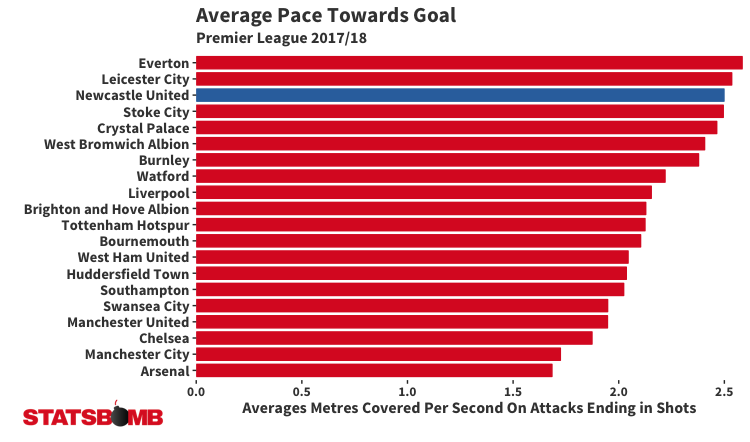 All of this this worked in the aggregate. But it wasn’t the smoothest ride. They dipped hard for a long period. Looking impotent on the attacking end and increasingly leaky in defence. A relegation-level stretch. For all of Benítez’s coaching chops, it's still a tad worrying at times, watching them barely even get out of their own half in some matches. Absorbing attack after attack.
All of this this worked in the aggregate. But it wasn’t the smoothest ride. They dipped hard for a long period. Looking impotent on the attacking end and increasingly leaky in defence. A relegation-level stretch. For all of Benítez’s coaching chops, it's still a tad worrying at times, watching them barely even get out of their own half in some matches. Absorbing attack after attack. 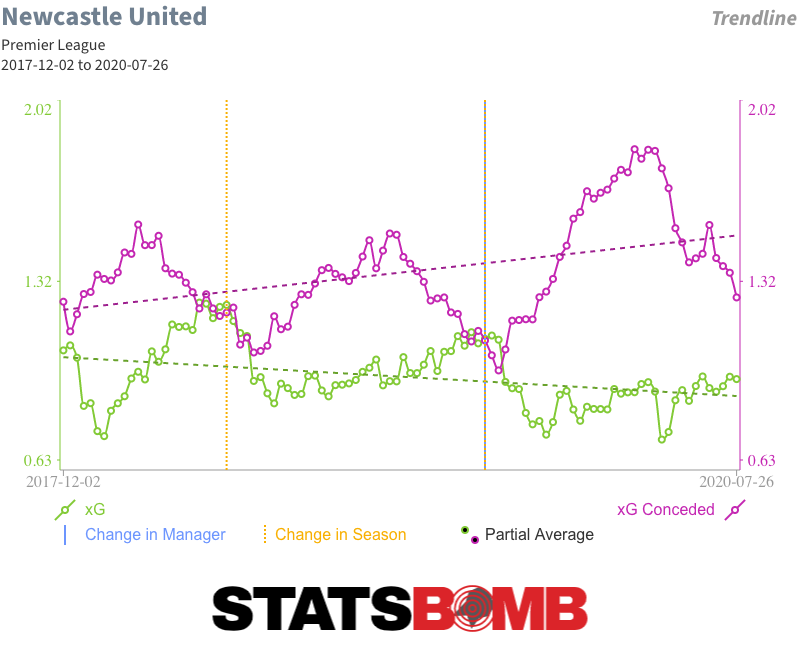 10th is no bad place to be of course, especially not for a promoted side. But to stay there you've gotta keep up with the Joneses. The talent level of your squad needs to be improving as every other team does the same around you. This summer's truncated transfer window shuts imminently and Newcastle's work to accomplish this has been...tumultuous. The most curious development has been at the striker position. No player broke the 10 goal mark in the league for them last season. Ayoze Perez, despite being functionally an attacking midfielder/striker mix, got the closest with eight goals in 2497 minutes. Dwight Gayle managed six, Joselu just four. That, plus the aforementioned underperformance on xG (whether you consider it a candidate for regression or otherwise), would suggest reinforcements are needed. Their main response to this thus far is to make a rarely-seen loan swap deal with West Bromwich Albion, bringing in Salomón Rondón and sending Dwight Gayle the other way. The Venezuelan notched an iffy seven goals in just shy of 3000 minutes last season, with some equally ugly underlying production. Theoretically he provides a real threat from set pieces (although Newcastle were already doing quite well in that department by xG) and in the air, taking the 3rd most headed shots in the league. Yet, even if you price in that he will have a few more opportunities in the north east than he did in 17/18 on a now relegated West Brom side, it isn't exactly lifting their attacking ceiling. Nor is there any upside here with a 28 year old we're quite familiar with already.
10th is no bad place to be of course, especially not for a promoted side. But to stay there you've gotta keep up with the Joneses. The talent level of your squad needs to be improving as every other team does the same around you. This summer's truncated transfer window shuts imminently and Newcastle's work to accomplish this has been...tumultuous. The most curious development has been at the striker position. No player broke the 10 goal mark in the league for them last season. Ayoze Perez, despite being functionally an attacking midfielder/striker mix, got the closest with eight goals in 2497 minutes. Dwight Gayle managed six, Joselu just four. That, plus the aforementioned underperformance on xG (whether you consider it a candidate for regression or otherwise), would suggest reinforcements are needed. Their main response to this thus far is to make a rarely-seen loan swap deal with West Bromwich Albion, bringing in Salomón Rondón and sending Dwight Gayle the other way. The Venezuelan notched an iffy seven goals in just shy of 3000 minutes last season, with some equally ugly underlying production. Theoretically he provides a real threat from set pieces (although Newcastle were already doing quite well in that department by xG) and in the air, taking the 3rd most headed shots in the league. Yet, even if you price in that he will have a few more opportunities in the north east than he did in 17/18 on a now relegated West Brom side, it isn't exactly lifting their attacking ceiling. Nor is there any upside here with a 28 year old we're quite familiar with already. 
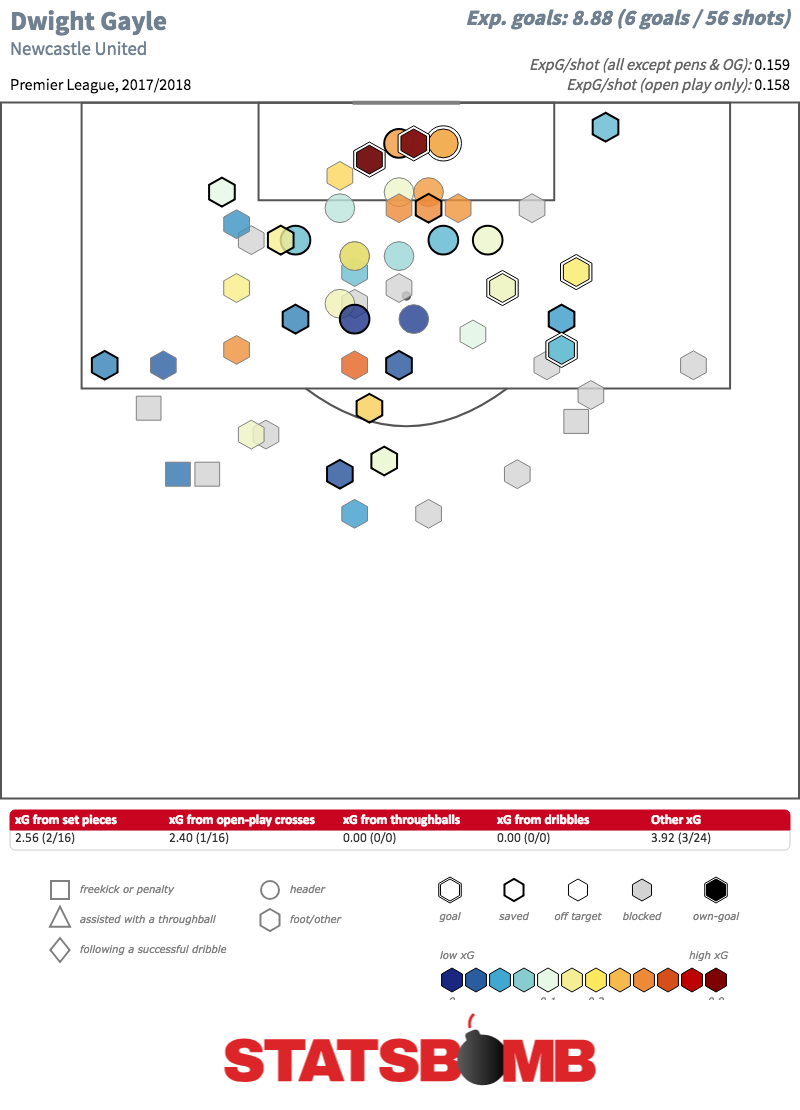 Elsewhere they've rescued Ki-Sung-yueng from Swansea on a free, Yoshinori Mutō as further forward depth, Fabian Schär at centre-back, goalkeeper Martin Dúbravka (who they had on loan last season), and Kenedy back in for a second loan season. On the outs, amongst many released players, are midfielder Mikel Merino, Chancel Mbemba and Aleksandar Mitrović. The last of those being particularly odd as the Serb may have been a solution for their goalscoring issues. Now he's at newly-promoted Fulham and directly competing against them in the league table. The incomings are all solid enough, but they're not really moving things forward. Newcastle are essentially replacing outgoing players at their positions - even if it isn’t exactly like-for-like - and re-upping some loans. There's not much improvement or diversification. The squad is in largely the same place it was previously, right when they need to be stacking more talent on top. Ostensibly this is because Ashley doesn't want to do much more. Of course this may not even end up as a concern at all. Being roughly the same level as you were previously when you comfortably avoided relegation and broke into the top half isn't disastrous on its face. Yet when you're in the mix with those 'could fall into a relegation battle' teams (and several of those are stronger this year), that risk is always there. The more existential fear is how clearly miffed Benítez is about the whole situation. It seems every other day there's a new headline about how he and Ashley are clashing over buying players. This story from the Guardian features these almost parodically portentous quotes:
Elsewhere they've rescued Ki-Sung-yueng from Swansea on a free, Yoshinori Mutō as further forward depth, Fabian Schär at centre-back, goalkeeper Martin Dúbravka (who they had on loan last season), and Kenedy back in for a second loan season. On the outs, amongst many released players, are midfielder Mikel Merino, Chancel Mbemba and Aleksandar Mitrović. The last of those being particularly odd as the Serb may have been a solution for their goalscoring issues. Now he's at newly-promoted Fulham and directly competing against them in the league table. The incomings are all solid enough, but they're not really moving things forward. Newcastle are essentially replacing outgoing players at their positions - even if it isn’t exactly like-for-like - and re-upping some loans. There's not much improvement or diversification. The squad is in largely the same place it was previously, right when they need to be stacking more talent on top. Ostensibly this is because Ashley doesn't want to do much more. Of course this may not even end up as a concern at all. Being roughly the same level as you were previously when you comfortably avoided relegation and broke into the top half isn't disastrous on its face. Yet when you're in the mix with those 'could fall into a relegation battle' teams (and several of those are stronger this year), that risk is always there. The more existential fear is how clearly miffed Benítez is about the whole situation. It seems every other day there's a new headline about how he and Ashley are clashing over buying players. This story from the Guardian features these almost parodically portentous quotes:
Rafael Benítez’s tenure as Newcastle’s manager looks to be reaching a pivotal moment after he claimed “everything” is wrong behind the scenes at St James’ Park. "When things are not going well off the pitch you can see a reflection on the pitch,” Benítez said after Wednesday’s 4-0 friendly defeat at Braga in northern Portugal. Pressed as to whether he was referring to recruitment at a club showing a profit on summer dealing, he replied: “Everything – I’m really worried.” asked if there was money to spend or any deals were close he said: “I have no idea. The fans have to be concerned, we are concerned. I’m really worried.”
Evidently he is worried. This is the running fear if you're a Newcastle supporter. At best this is Benítez - potentially harmfully - pulling some public power plays on transfers. At worst it's actively driving out the manager and arguably the most positive aspect the club has had in yonks. In any reasonable scenario, the club will likely be fine next season. Avoiding relegation and finishing somewhere around 10th again is well within grasp. Beyond that though lies a minefield of possibilities that we can't anticipate.
Thank you for reading. More information about StatsBomb, and the rest of our season previews can be found here.
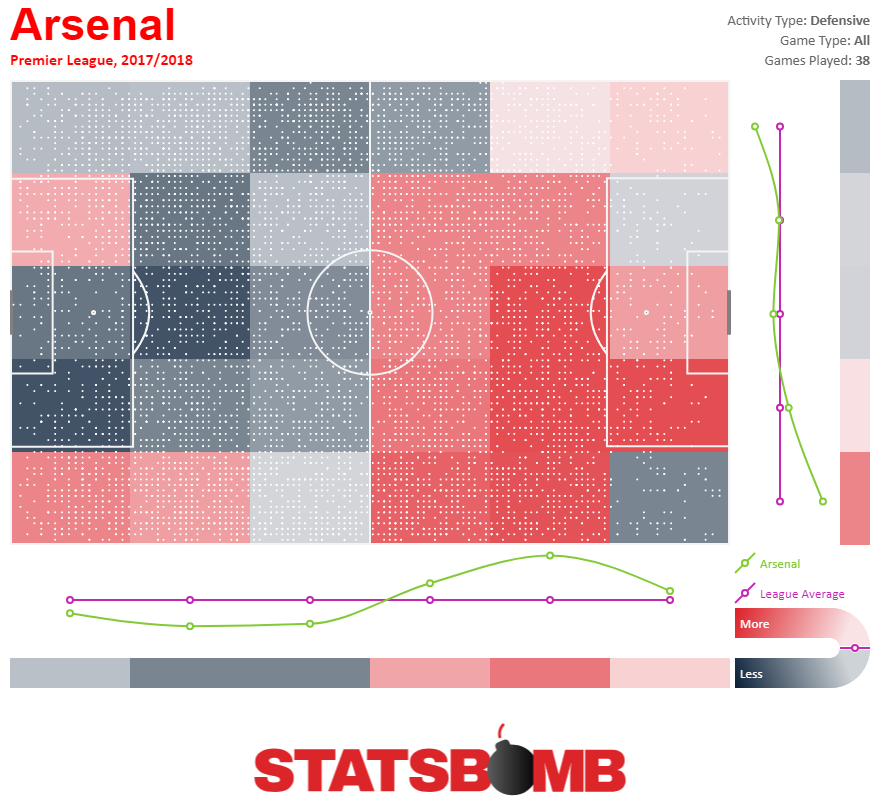

 Losing a star is hard, but Arsenal went out and replaced Sanchez with Pierre-Emerick Aubameyang. By the time their new striker arrived, it was relatively clear that Arsenal were not going to finish in the top four, so Aubameyang’s star turn largely went unnoticed. Arsenal’s new striker wasn’t the creative force Sanchez was, but he was absolutely unparalleled in the Premier League at getting great shots for himself.
Losing a star is hard, but Arsenal went out and replaced Sanchez with Pierre-Emerick Aubameyang. By the time their new striker arrived, it was relatively clear that Arsenal were not going to finish in the top four, so Aubameyang’s star turn largely went unnoticed. Arsenal’s new striker wasn’t the creative force Sanchez was, but he was absolutely unparalleled in the Premier League at getting great shots for himself.  Nobody in the Premier League was better than Aubameyang at taking great shots. Of players that played more than 600 minutes and averaged over a shot per 90 (basically players who played a bunch and also had at least some responsibility for trying to score the ball), nobody averaged higher than Aubameyang’s 0.24 xG per shot. It helps that Aubameyang gets to play in front of a great playmaker like Mesut Ozil on a weekly basis. Say what you will about Ozil, and lord knows everybody has, but he is consistently an incredible passer of the ball. Of players that played more than 1200 minutes last season only Kevin De Bruyne of the unstoppable Manchester City attack had more expected goals assisted per 90 minutes than Ozil’s 0.33 and only Fernandinho, of that same attack had more deep ball progressions per 90 (that’s passes, dribbles and carries into the opponents final third) than Ozil’s 11.65. Ozil’s ability to combine progressing the ball up the field from deeper areas and finding the killer pass to create great chances in the final third is absolutely unique. Henrikh Mkhitaryan, who Arsenal acquired from Manchester United as part of the deal for Sanchez leaving, is a wonderful passer as well. While he might not provide quite enough of an impact as the lead creative force in an attack, as a secondary passer, supporting Ozil, he’s been phenomenal. He doesn’t make the 1200 minute cutoff with Arsenal, he only played a little under 850 minutes, but his 0.28 expected goals assisted per 90 would have ranked him 11th on the list. It’s a number made even more impressive since he largely isn’t on set piece duty thanks to Ozil. As Mkhitaryan supports Ozil in the final third, Granit Xhaka supports him in deeper areas. There are certainly many holes in Xhaka’s game, mostly stemming from his lack of mobility and defensive range, but his passing from deep is exceptional. He was third in the league in deep progressions with 11.35 per 90 minutes. Put it all together and it paints the picture of a cohesive attacking squad. Ozil is a creative hub all over the pitch and he gets support from Mkhitaryan and Xhaka. Meanwhile, Aubameyang is free to destroy defenders in the penalty box. And that’s before getting to the scoring and link-up support of last summer’s big signing Alexandre Lacazette. Arsenal’s attack is simply very good.
Nobody in the Premier League was better than Aubameyang at taking great shots. Of players that played more than 600 minutes and averaged over a shot per 90 (basically players who played a bunch and also had at least some responsibility for trying to score the ball), nobody averaged higher than Aubameyang’s 0.24 xG per shot. It helps that Aubameyang gets to play in front of a great playmaker like Mesut Ozil on a weekly basis. Say what you will about Ozil, and lord knows everybody has, but he is consistently an incredible passer of the ball. Of players that played more than 1200 minutes last season only Kevin De Bruyne of the unstoppable Manchester City attack had more expected goals assisted per 90 minutes than Ozil’s 0.33 and only Fernandinho, of that same attack had more deep ball progressions per 90 (that’s passes, dribbles and carries into the opponents final third) than Ozil’s 11.65. Ozil’s ability to combine progressing the ball up the field from deeper areas and finding the killer pass to create great chances in the final third is absolutely unique. Henrikh Mkhitaryan, who Arsenal acquired from Manchester United as part of the deal for Sanchez leaving, is a wonderful passer as well. While he might not provide quite enough of an impact as the lead creative force in an attack, as a secondary passer, supporting Ozil, he’s been phenomenal. He doesn’t make the 1200 minute cutoff with Arsenal, he only played a little under 850 minutes, but his 0.28 expected goals assisted per 90 would have ranked him 11th on the list. It’s a number made even more impressive since he largely isn’t on set piece duty thanks to Ozil. As Mkhitaryan supports Ozil in the final third, Granit Xhaka supports him in deeper areas. There are certainly many holes in Xhaka’s game, mostly stemming from his lack of mobility and defensive range, but his passing from deep is exceptional. He was third in the league in deep progressions with 11.35 per 90 minutes. Put it all together and it paints the picture of a cohesive attacking squad. Ozil is a creative hub all over the pitch and he gets support from Mkhitaryan and Xhaka. Meanwhile, Aubameyang is free to destroy defenders in the penalty box. And that’s before getting to the scoring and link-up support of last summer’s big signing Alexandre Lacazette. Arsenal’s attack is simply very good.  The problem stems directly from their pressing issues. Those counterattack woes can be linked specifically to the team trying to defend in the attacking half and failing at it. They’re one of the worst teams in the league when it comes to conceding opportunities within 20 seconds of a defensive action in their opponents half.
The problem stems directly from their pressing issues. Those counterattack woes can be linked specifically to the team trying to defend in the attacking half and failing at it. They’re one of the worst teams in the league when it comes to conceding opportunities within 20 seconds of a defensive action in their opponents half.  New Defensive Recruits Those numbers call out for some better players, or a new approach, or both. And Arsenal seem to have opted for option both. New manager Emery has a history of being a strong defensive manager (a history which was itself an awkward fit at Paris Saint-Germain, his last stop before Arsenal), and he turned Sevilla into a Europa League powerhouse by building a strong base and grafting exciting attackers on top of that. Arsenal have the exciting attacking talent, now it remains to be seen if Emery can reverse engineer the base. Critical to that endeavor will be Lucas Torreira, the 22 year old defensive midfield prospect acquired from Sampdoria. Torreira profiles like a good young midfielder. His creative passing may leave something to be desired, but his defensive range and ability are enough to at least hint at a big future nailing down the middle of the pitch for Arsenal. His transition will also be eased by the fact that Emery will almost certainly not leave him nearly as isolated as Wenger would have. Further back, however, the business looks sketchier. Sokratis arrives from Borussia Dortmund, but he’s 30 and has some big Laurent Koscielny sized shoes to fill. Koscielny is still months away from recovering from an achilles injury, meaning that Sokratis arrives as more of a direct replacement than an upgrade to the team’s depth. And at keeper, as Petr Cech’s career winds down, Arsenal have looked to Bernd Leno to be his long-term replacement. But there are significant questions about whether Leno is actually a good shot stopper at all. He his hard to analyze, having played a significant portion of his career behind a Bayer Leverkusen press that redefined the limits of the possible (if not always the limits of the wise) when it comes to pressing. But, even in the more normal tactical seasons of his career, he hasn't exactly impressed. All in all, Arsenal seem to have addressed the positions that need addressing, but outside of Torreira there’s reason to believe that they didn’t address them well enough. A Ray of Optimism The good news for Arsenal is that while they have been taking steps to improve what ails them, imperfect as those steps may be, other teams have not. The nightmare scenario for Arsenal was always that after falling out of the top four, their main competitors would slam the door behind them. That hasn’t happened. United haven’t addressed any of the problems that caused them to need David De Gea to be their savior. Spurs, haven’t done anything at all and Chelsea’s managerial change has certainly ensured that they’ll be different, but that’s not the same thing as being better. Only Liverpool have unequivocally continued to lengthen the distance between themselves and Arsenal. There are real and ongoing problems with this Arsenal squad. Despite the Torreira addition, Arsenal are trending dangerously old. Most of their young prospects have yet to develop into reliable players who can contribute week in and week out at the top of the Premier League. Those kinds of problems loom large for the future of the club, but they aren’t immediately pressing concerns for this season. Arsenal’s present looks brighter than its future at the moment. They have a lethal attack, and if Emery and his new signings can bring even a modicum of defensive stability to the side, they’ll be able to compete for a top four spot right now.
New Defensive Recruits Those numbers call out for some better players, or a new approach, or both. And Arsenal seem to have opted for option both. New manager Emery has a history of being a strong defensive manager (a history which was itself an awkward fit at Paris Saint-Germain, his last stop before Arsenal), and he turned Sevilla into a Europa League powerhouse by building a strong base and grafting exciting attackers on top of that. Arsenal have the exciting attacking talent, now it remains to be seen if Emery can reverse engineer the base. Critical to that endeavor will be Lucas Torreira, the 22 year old defensive midfield prospect acquired from Sampdoria. Torreira profiles like a good young midfielder. His creative passing may leave something to be desired, but his defensive range and ability are enough to at least hint at a big future nailing down the middle of the pitch for Arsenal. His transition will also be eased by the fact that Emery will almost certainly not leave him nearly as isolated as Wenger would have. Further back, however, the business looks sketchier. Sokratis arrives from Borussia Dortmund, but he’s 30 and has some big Laurent Koscielny sized shoes to fill. Koscielny is still months away from recovering from an achilles injury, meaning that Sokratis arrives as more of a direct replacement than an upgrade to the team’s depth. And at keeper, as Petr Cech’s career winds down, Arsenal have looked to Bernd Leno to be his long-term replacement. But there are significant questions about whether Leno is actually a good shot stopper at all. He his hard to analyze, having played a significant portion of his career behind a Bayer Leverkusen press that redefined the limits of the possible (if not always the limits of the wise) when it comes to pressing. But, even in the more normal tactical seasons of his career, he hasn't exactly impressed. All in all, Arsenal seem to have addressed the positions that need addressing, but outside of Torreira there’s reason to believe that they didn’t address them well enough. A Ray of Optimism The good news for Arsenal is that while they have been taking steps to improve what ails them, imperfect as those steps may be, other teams have not. The nightmare scenario for Arsenal was always that after falling out of the top four, their main competitors would slam the door behind them. That hasn’t happened. United haven’t addressed any of the problems that caused them to need David De Gea to be their savior. Spurs, haven’t done anything at all and Chelsea’s managerial change has certainly ensured that they’ll be different, but that’s not the same thing as being better. Only Liverpool have unequivocally continued to lengthen the distance between themselves and Arsenal. There are real and ongoing problems with this Arsenal squad. Despite the Torreira addition, Arsenal are trending dangerously old. Most of their young prospects have yet to develop into reliable players who can contribute week in and week out at the top of the Premier League. Those kinds of problems loom large for the future of the club, but they aren’t immediately pressing concerns for this season. Arsenal’s present looks brighter than its future at the moment. They have a lethal attack, and if Emery and his new signings can bring even a modicum of defensive stability to the side, they’ll be able to compete for a top four spot right now. 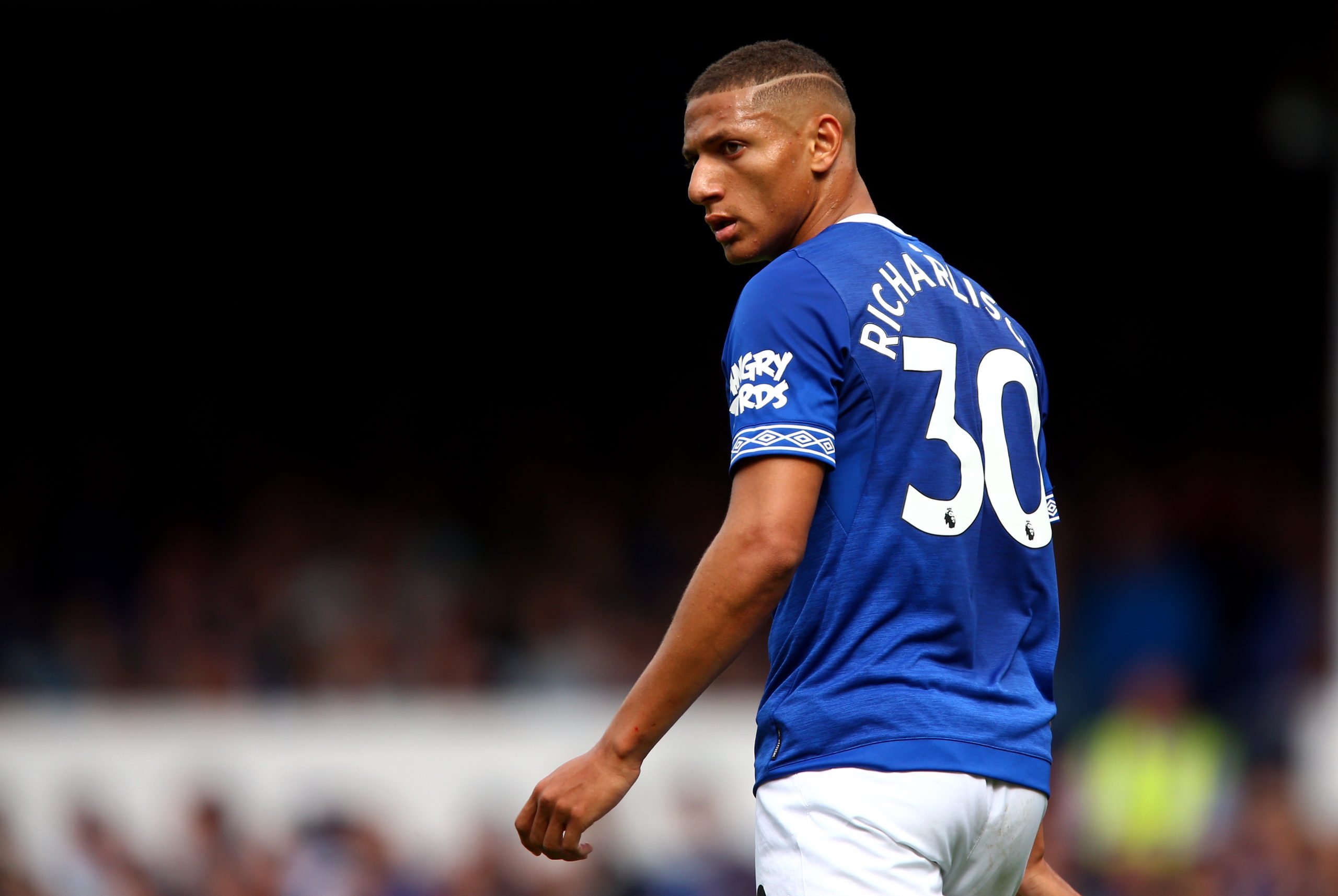
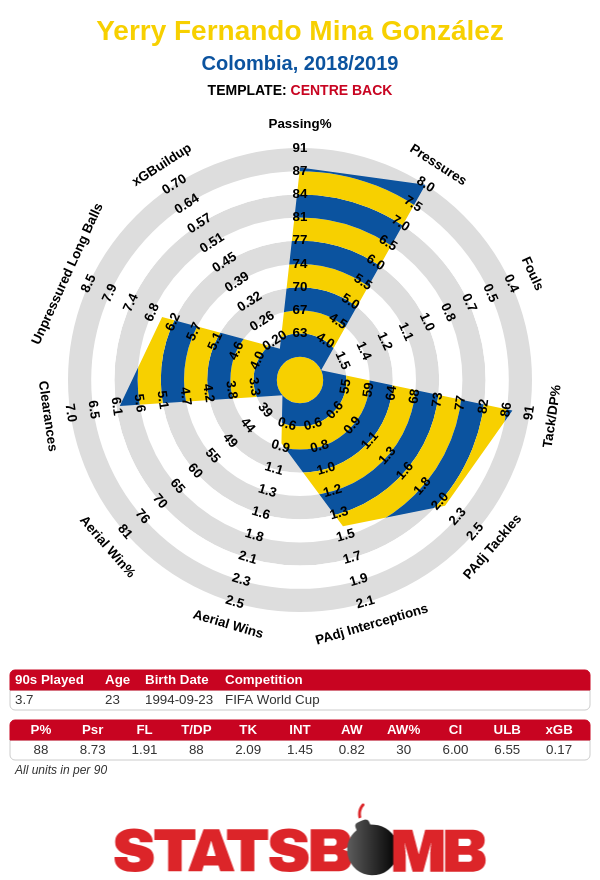
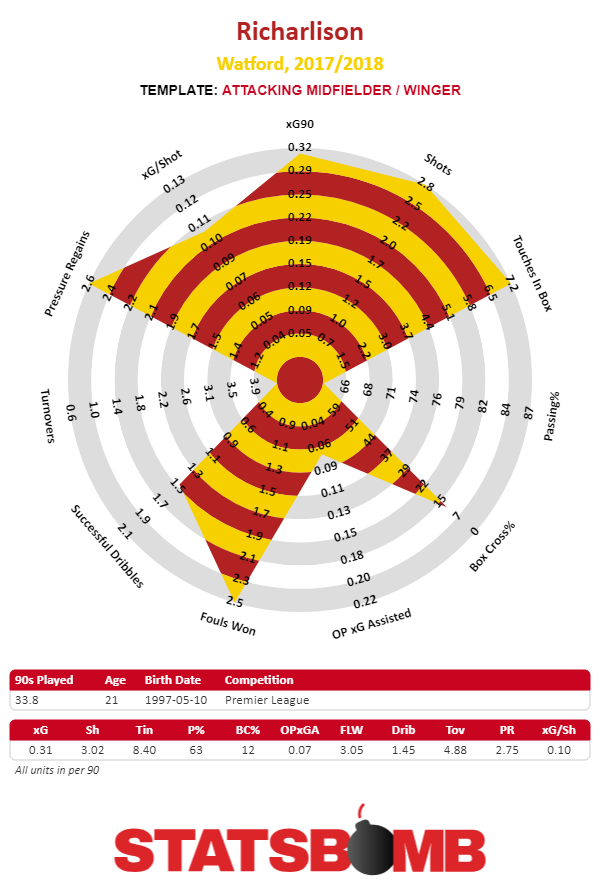
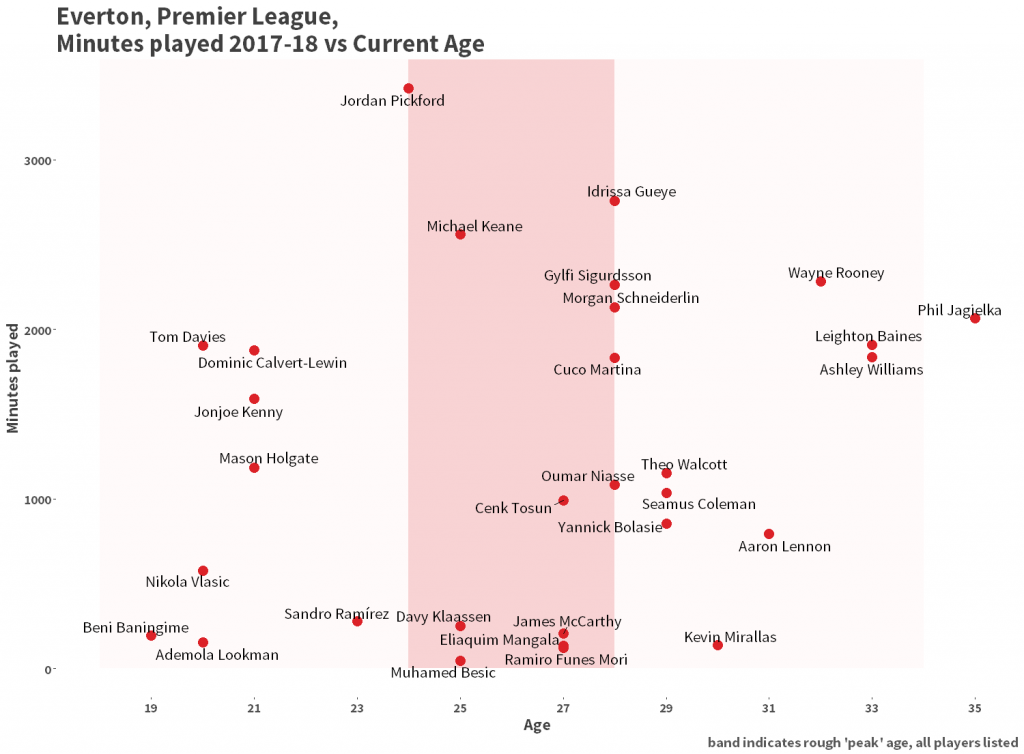
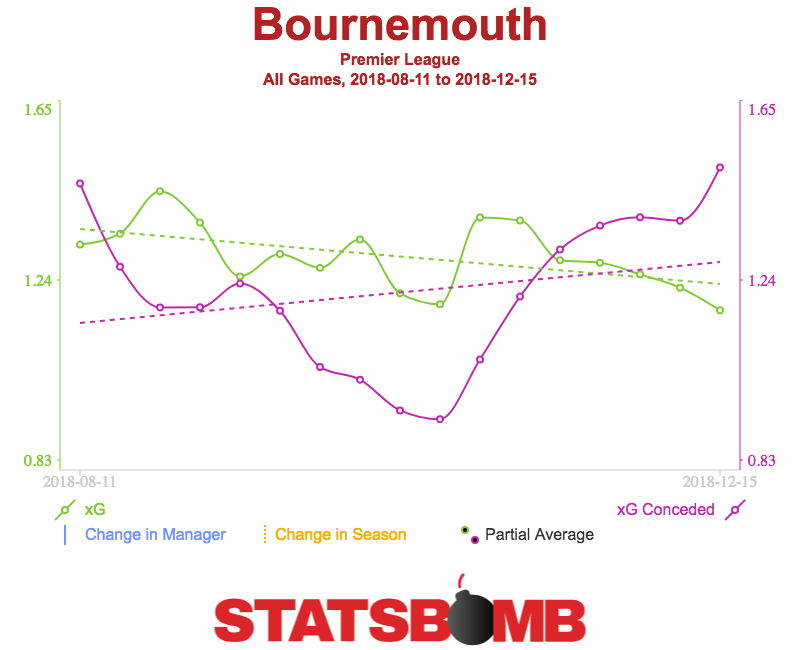
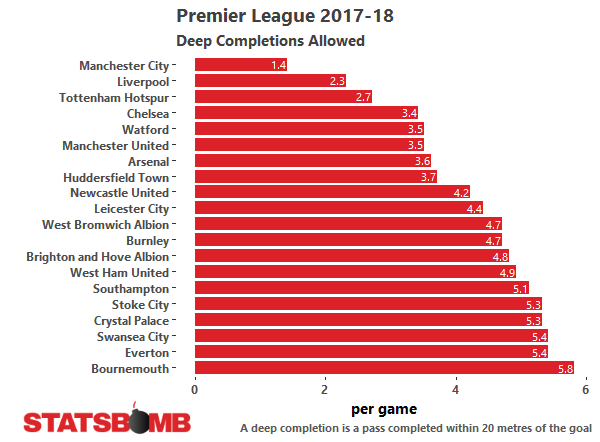 It’s really easy to complete passes close to Bournemouth’s goal. Why might that be?
It’s really easy to complete passes close to Bournemouth’s goal. Why might that be? 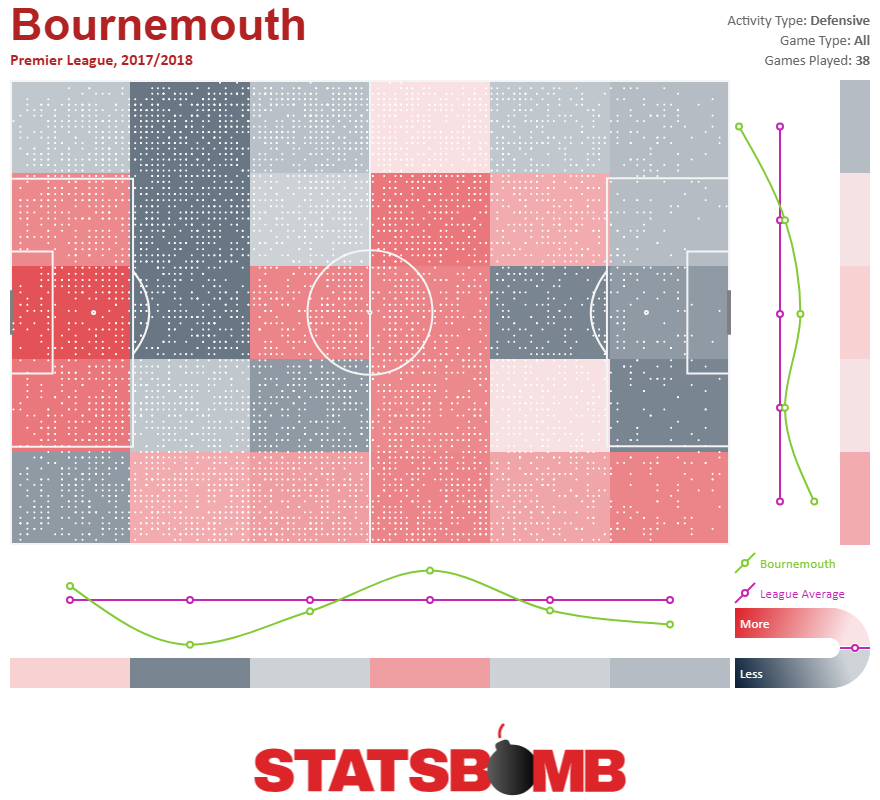 ...because Bournemouth’s volume of defensive activity in the band ahead of the box is well below league average. Teams can get through Bournemouth's midfield and enact play in the deepest zones. As such Bournemouth put in an above average volume of last ditch defending, but ahead of that their midfield was porous. This chart also tells us more about the way Bournemouth deploy their defensive resources higher up the pitch. Joshua King, Callum Wilson and Jermain Defoe all ranked in the top 25 for the division for volume of opposition half pressure events--which we can see represented in the red segments ahead of the halfway line. It's just what takes place in between doesn't quite pass muster. Bournemouth can attack looking like an above average Premier League team, but scarcely look anything but below average at the back. While King moved his position out of the centre somewhat and understandably saw his goal totals reduce having come down from his 2016-17 finishing bender (but that's
...because Bournemouth’s volume of defensive activity in the band ahead of the box is well below league average. Teams can get through Bournemouth's midfield and enact play in the deepest zones. As such Bournemouth put in an above average volume of last ditch defending, but ahead of that their midfield was porous. This chart also tells us more about the way Bournemouth deploy their defensive resources higher up the pitch. Joshua King, Callum Wilson and Jermain Defoe all ranked in the top 25 for the division for volume of opposition half pressure events--which we can see represented in the red segments ahead of the halfway line. It's just what takes place in between doesn't quite pass muster. Bournemouth can attack looking like an above average Premier League team, but scarcely look anything but below average at the back. While King moved his position out of the centre somewhat and understandably saw his goal totals reduce having come down from his 2016-17 finishing bender (but that's 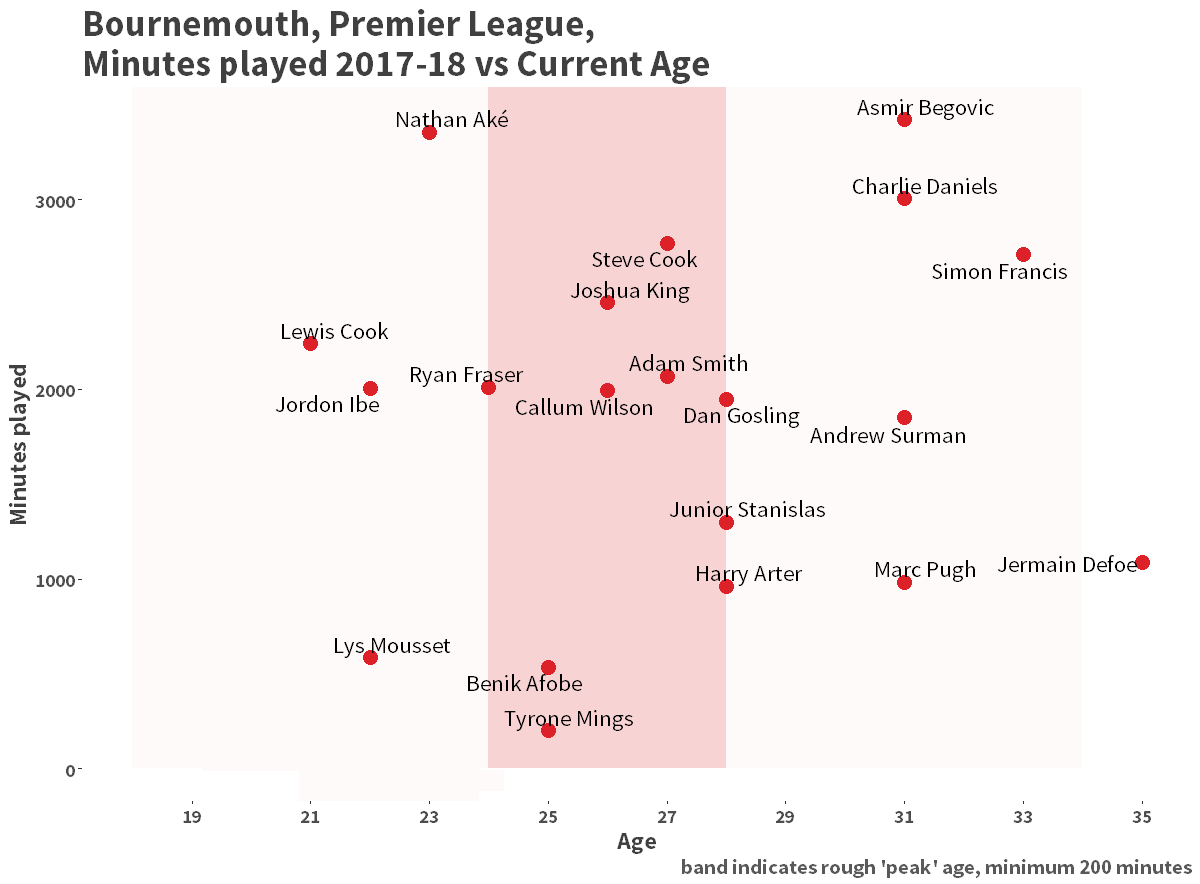
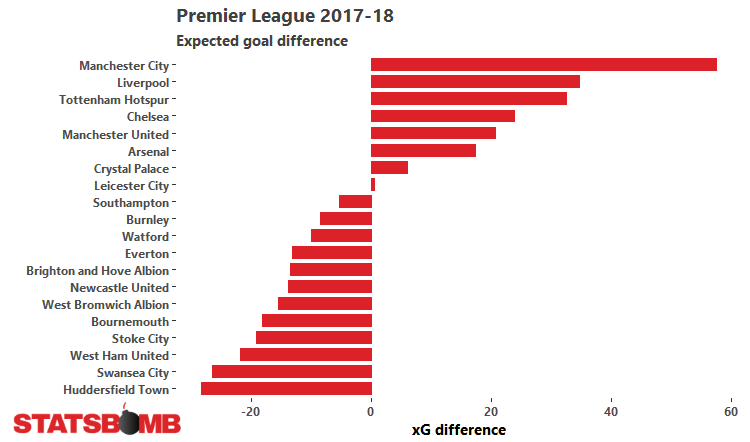
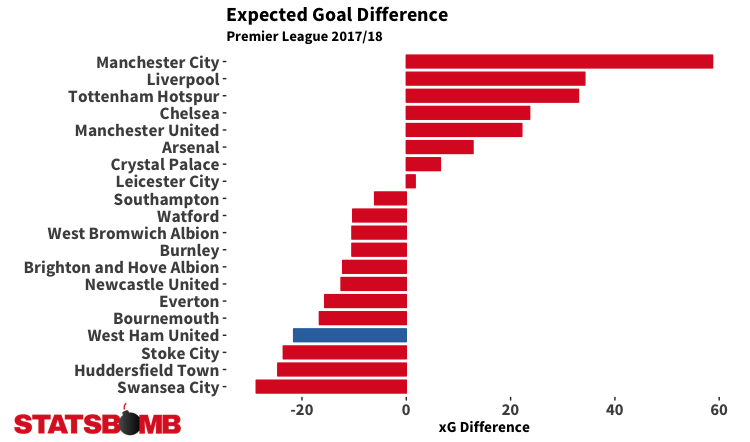
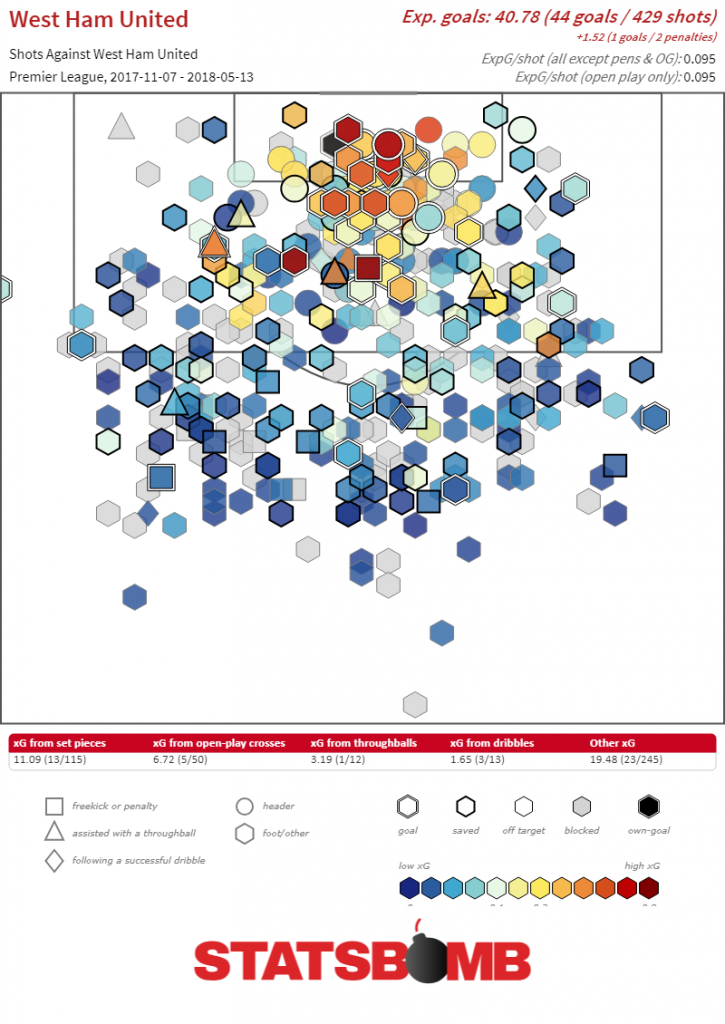
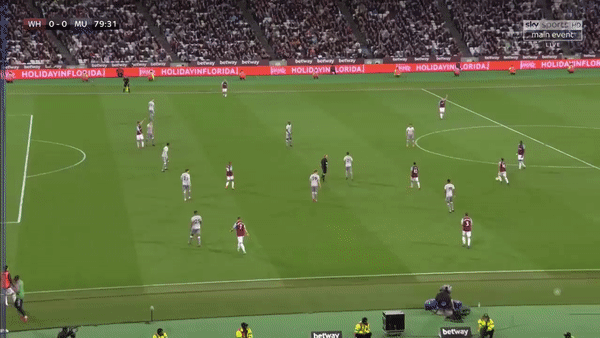 Defensively, West Ham defended in a manner that you would've expected from them, a low block with very little sustained pressure on the ball higher up the pitch. Only Brighton and Crystal Palace had their average location of defensive events closer to goal than West Ham. Defending in a low block isn't a bad thing if done properly, because it negates pass opportunities into the middle and forces the opposition to stay out in the wide areas which are more inefficient in terms of creating opportunities. As a low block defense, the goal is either forcing the opposition to cross from deep or forcing the opposition to settle for low quality shots. But as the shot suppression and quality numbers references early show, that wasn't the case with West Ham. The low block simply didn't accomplish it's goals. Additionally, they were 13th in allowing passes completed within 20 meters of goal. West Ham gave up prime real estate to opponents without much of a fight.
Defensively, West Ham defended in a manner that you would've expected from them, a low block with very little sustained pressure on the ball higher up the pitch. Only Brighton and Crystal Palace had their average location of defensive events closer to goal than West Ham. Defending in a low block isn't a bad thing if done properly, because it negates pass opportunities into the middle and forces the opposition to stay out in the wide areas which are more inefficient in terms of creating opportunities. As a low block defense, the goal is either forcing the opposition to cross from deep or forcing the opposition to settle for low quality shots. But as the shot suppression and quality numbers references early show, that wasn't the case with West Ham. The low block simply didn't accomplish it's goals. Additionally, they were 13th in allowing passes completed within 20 meters of goal. West Ham gave up prime real estate to opponents without much of a fight. 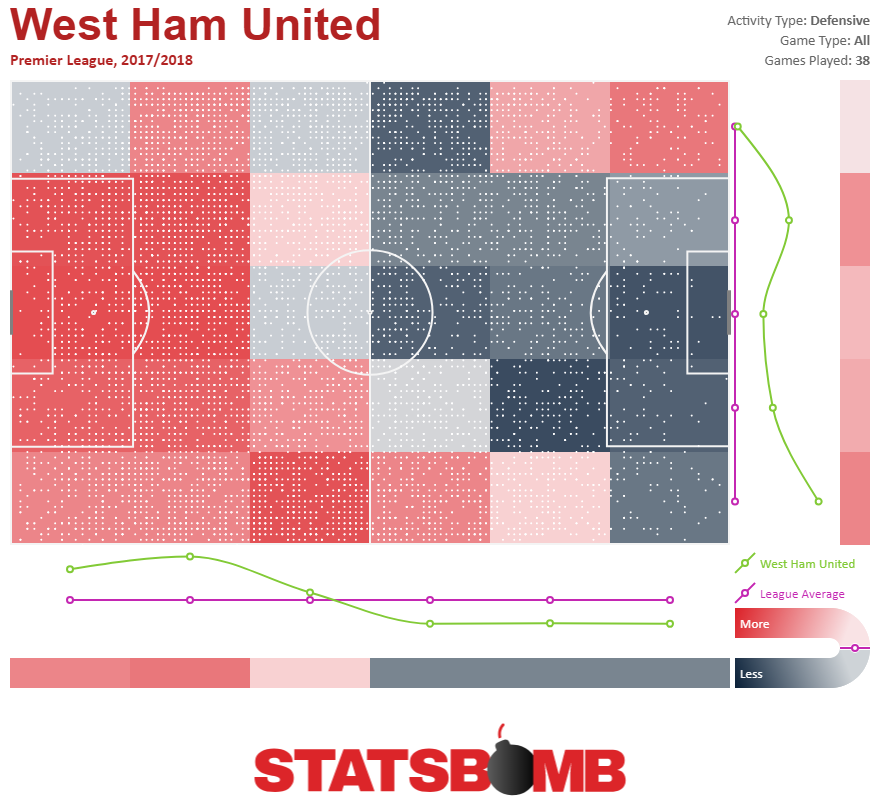

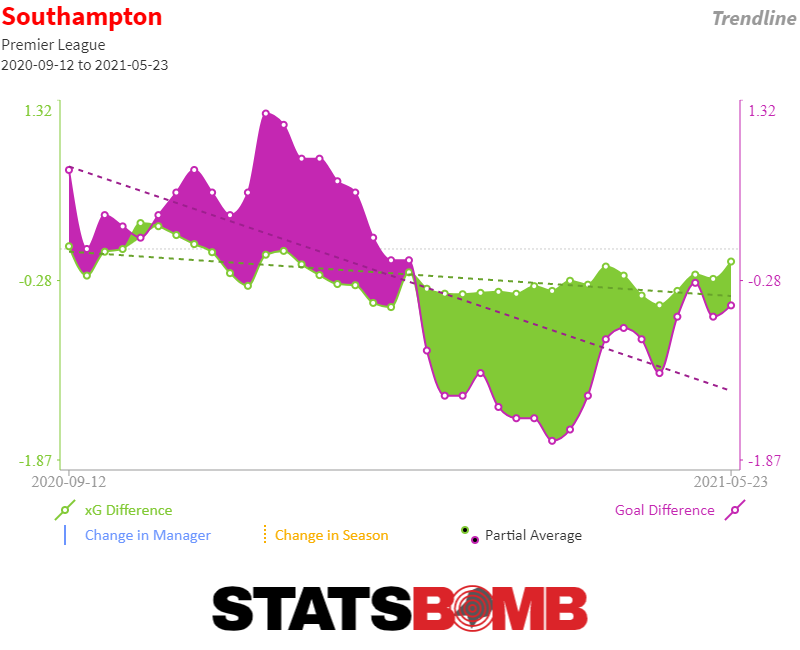
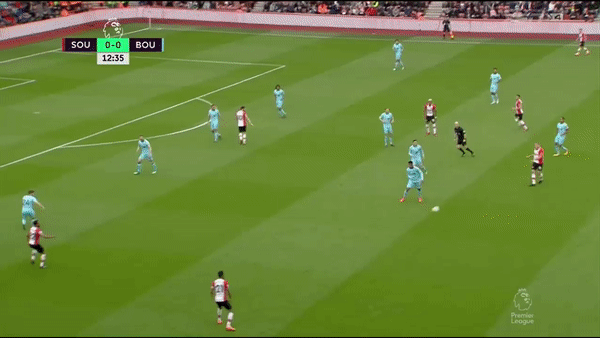
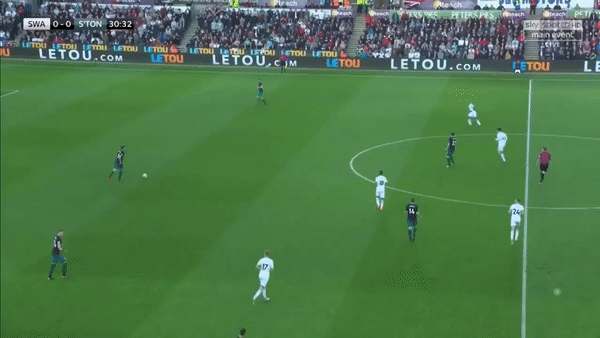
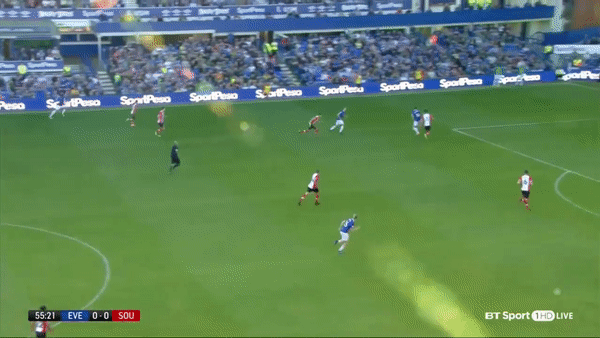
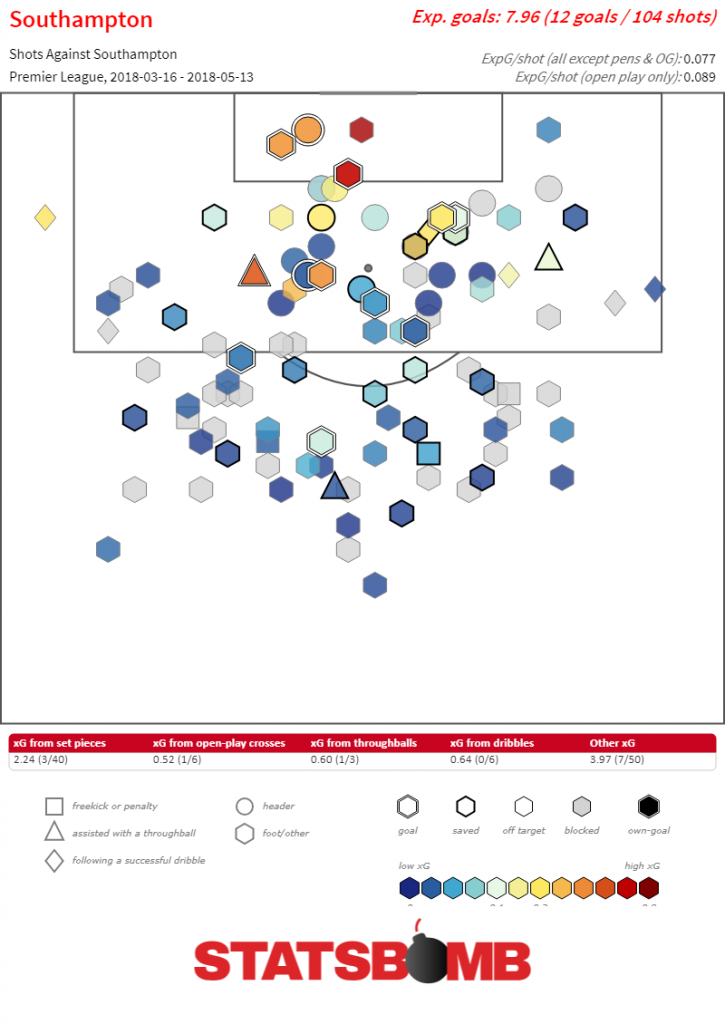
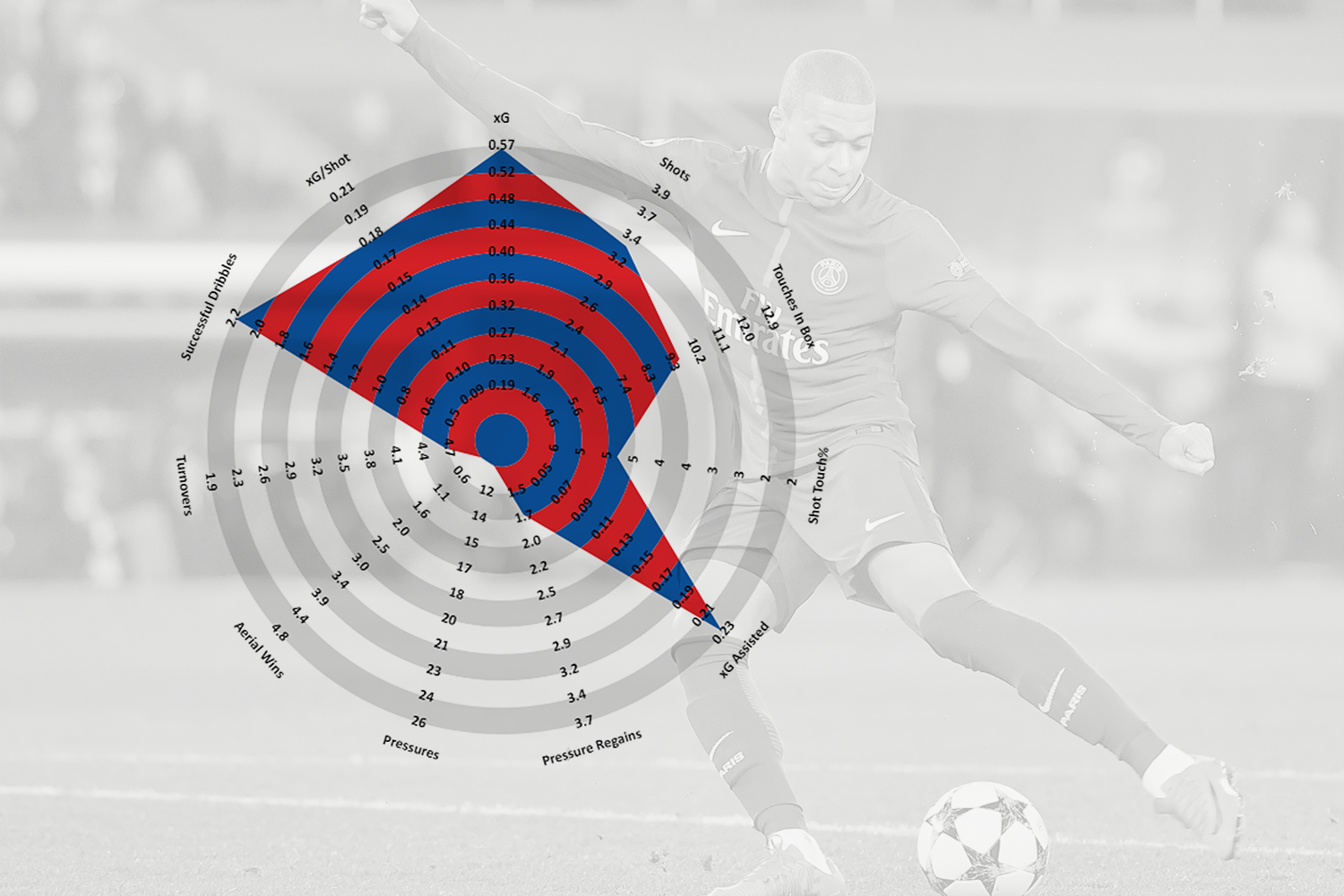
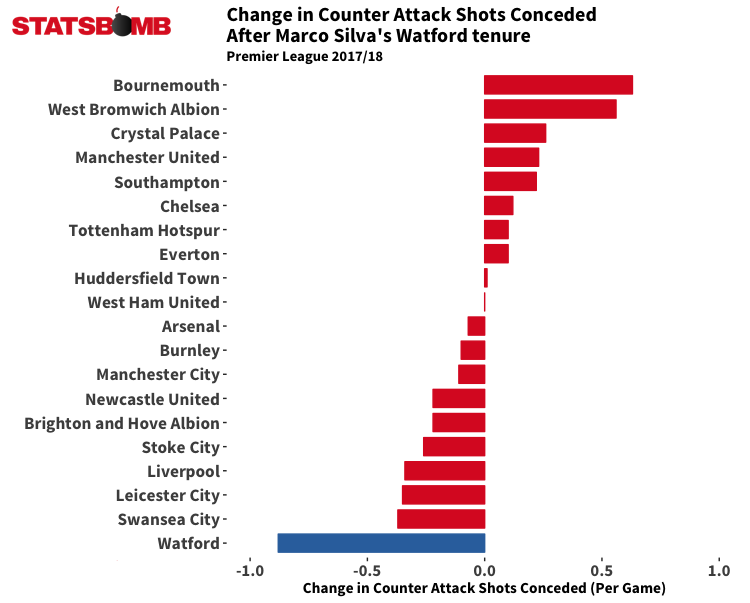
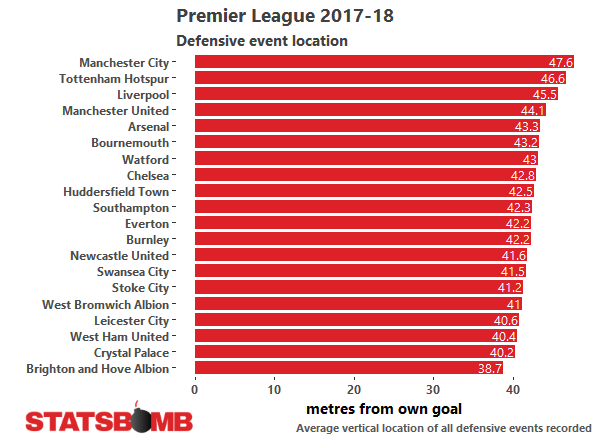
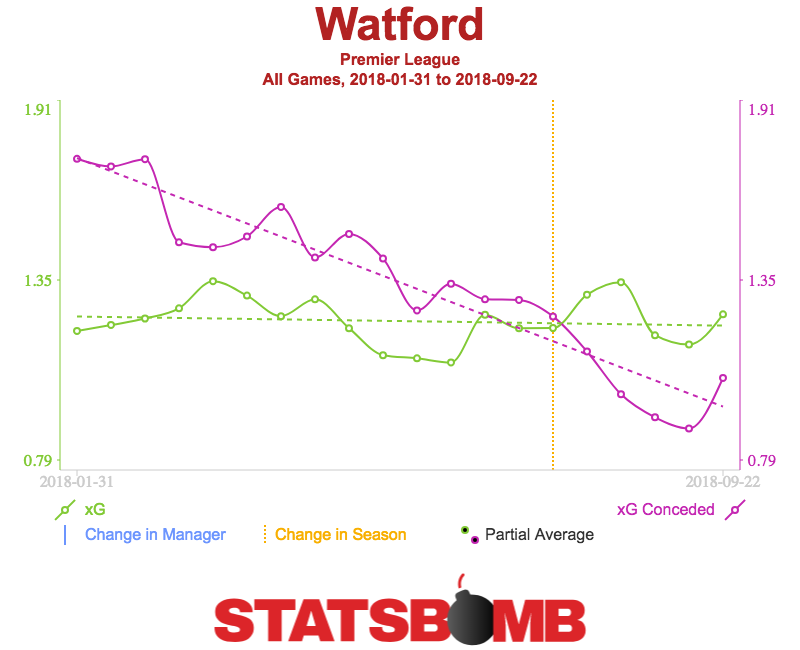
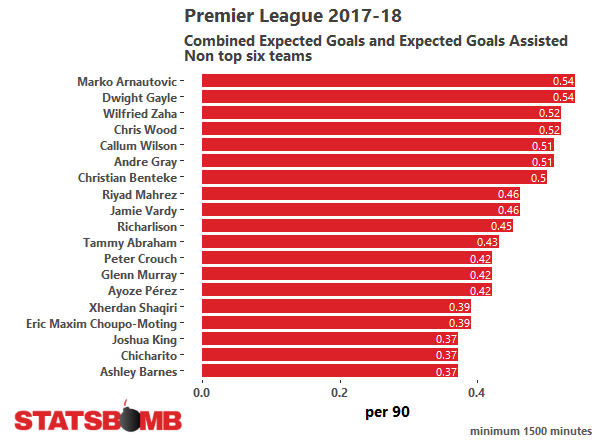
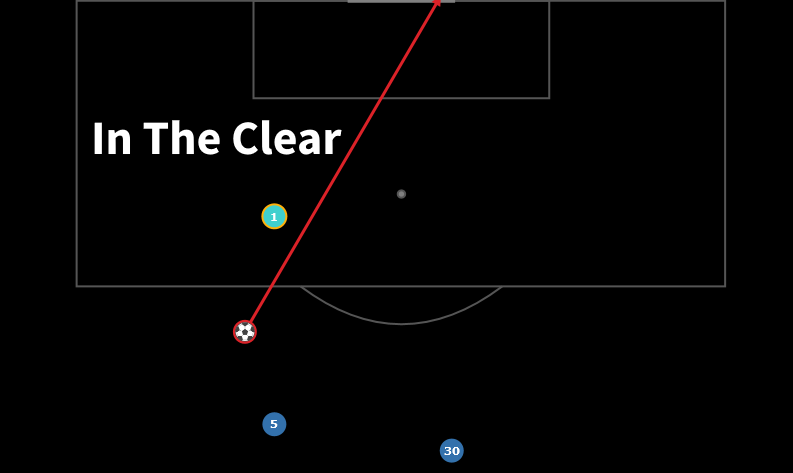
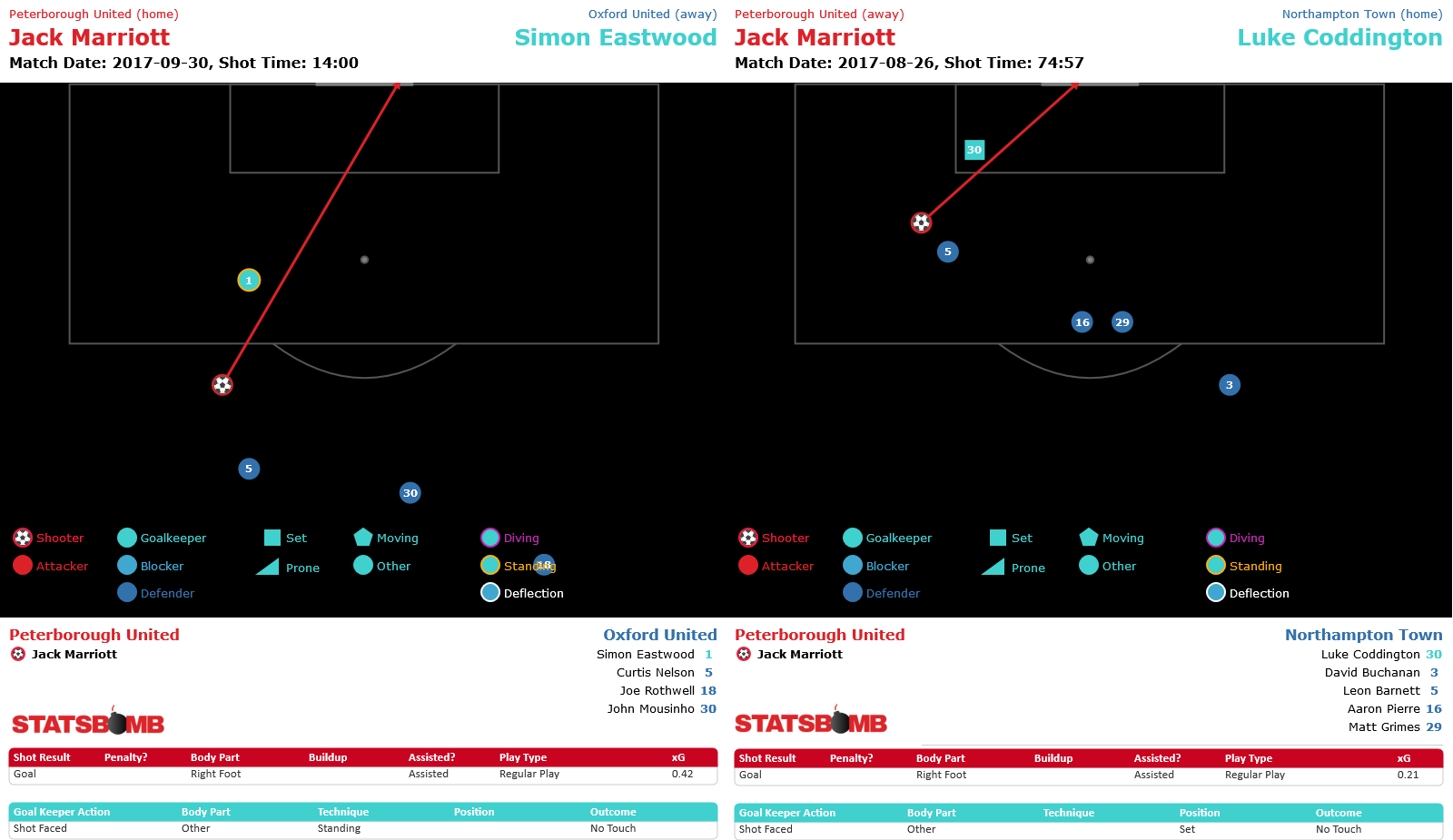 As we can see, the defence trails behind him and he's significantly ahead of his teammates--none of whom are in the frame. These are particularly obvious examples, but a free header would likely also qualify as would plenty of shots in which the player has made space for a shot quite normally. So how did League One shape up in total? Let's look at how many of each team's shots were In The Clear:
As we can see, the defence trails behind him and he's significantly ahead of his teammates--none of whom are in the frame. These are particularly obvious examples, but a free header would likely also qualify as would plenty of shots in which the player has made space for a shot quite normally. So how did League One shape up in total? Let's look at how many of each team's shots were In The Clear: 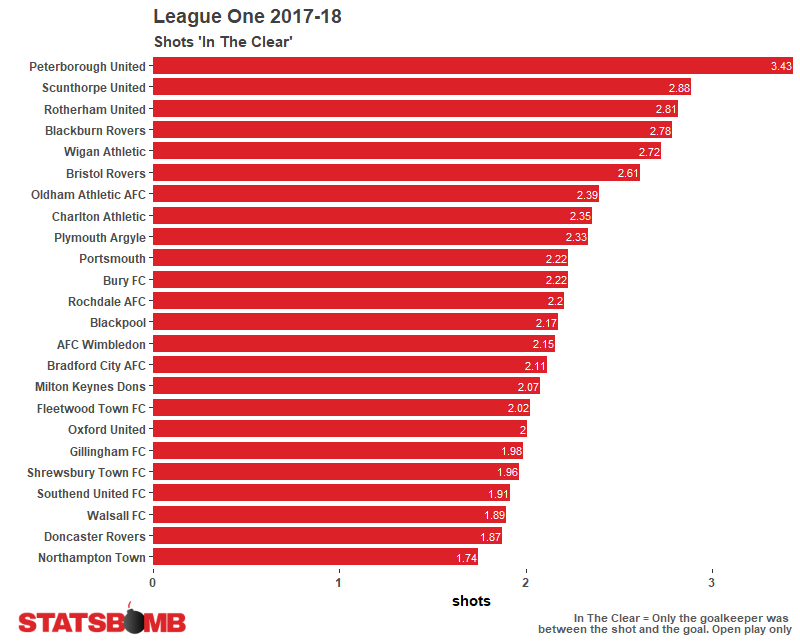 Peterborough (powered at least in part by Marriott) created the highest percentage of shots here, and in fact Marriott himself not only led the league for shot volume but also for in the clear volume too. Of the players with 100 shots or more in the division, the player with the highest percentage of in the clear shots was Ellis Harrison, the player with the lowest percentage was Nick Powell:
Peterborough (powered at least in part by Marriott) created the highest percentage of shots here, and in fact Marriott himself not only led the league for shot volume but also for in the clear volume too. Of the players with 100 shots or more in the division, the player with the highest percentage of in the clear shots was Ellis Harrison, the player with the lowest percentage was Nick Powell: 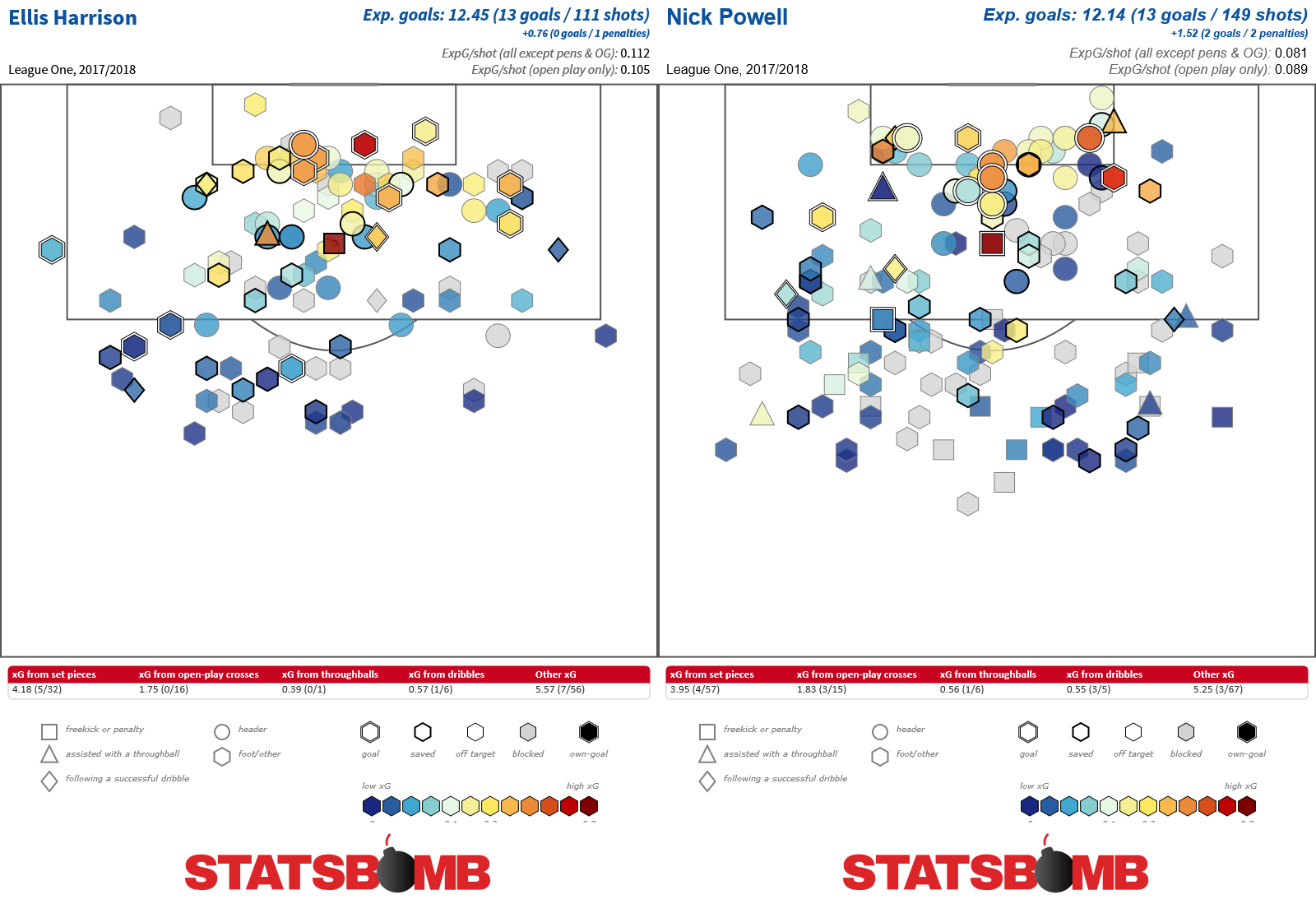 Visually the differences aren't hugely pronounced between the two players, but we know that Harrison took a ton more shots that were in the clear while Powell's total was augmented by lower value less clear shots from range. So we've added an extra layer to our shooting analysis, thanks to the information contained in the Freeze Frames. As mentioned, this is just a starting point but we have a great basic example of scalable data analysis that once enacted can be applied across an entire dataset, be that a single league or many.
Visually the differences aren't hugely pronounced between the two players, but we know that Harrison took a ton more shots that were in the clear while Powell's total was augmented by lower value less clear shots from range. So we've added an extra layer to our shooting analysis, thanks to the information contained in the Freeze Frames. As mentioned, this is just a starting point but we have a great basic example of scalable data analysis that once enacted can be applied across an entire dataset, be that a single league or many. 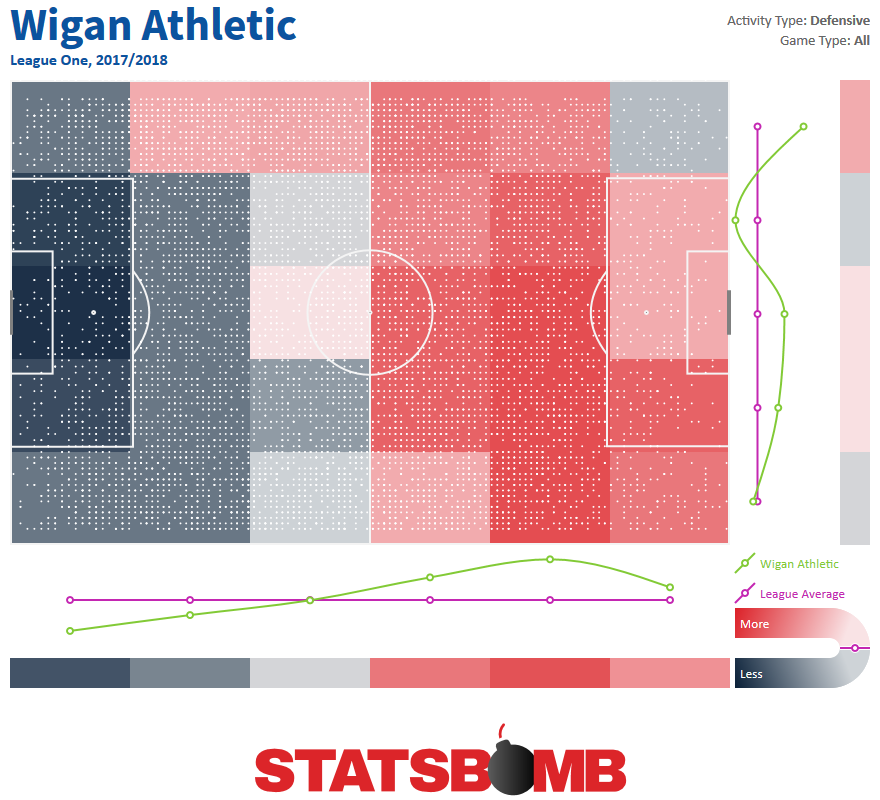 By way of contrast, Bradford City recorded the fewest pressure events in the opposition half in the division--over eight per game fewer than next lowest Oldham Athletic:
By way of contrast, Bradford City recorded the fewest pressure events in the opposition half in the division--over eight per game fewer than next lowest Oldham Athletic: 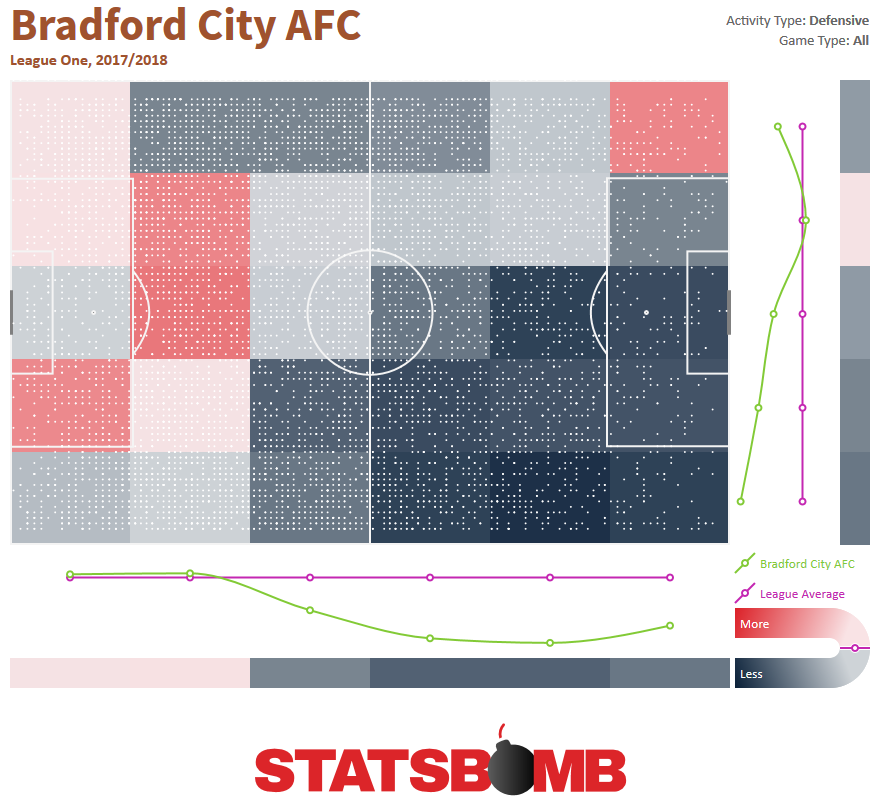 Their passivity extended over most of the pitch but perhaps crucially not within their own defensive zone. Overall, this less aggressive style did not appear to have had a strong negative impact on their performances as they landed squarely in mid-table in eleventh place. However, they offer a distinct contrast to every other team in League One in skewing so heavily away from pressure events up the pitch. In relation to players, a willingness to chase down the opposition can be a useful string to a forward's bow as Devante Cole found. He had a stellar first half to 2017-18 at Fleetwood Town, part of which meant that he led the league for opposition half pressure events per game:
Their passivity extended over most of the pitch but perhaps crucially not within their own defensive zone. Overall, this less aggressive style did not appear to have had a strong negative impact on their performances as they landed squarely in mid-table in eleventh place. However, they offer a distinct contrast to every other team in League One in skewing so heavily away from pressure events up the pitch. In relation to players, a willingness to chase down the opposition can be a useful string to a forward's bow as Devante Cole found. He had a stellar first half to 2017-18 at Fleetwood Town, part of which meant that he led the league for opposition half pressure events per game: 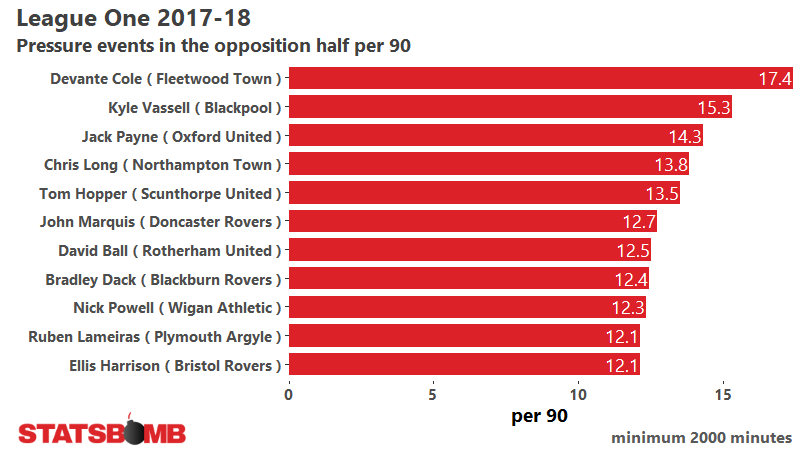
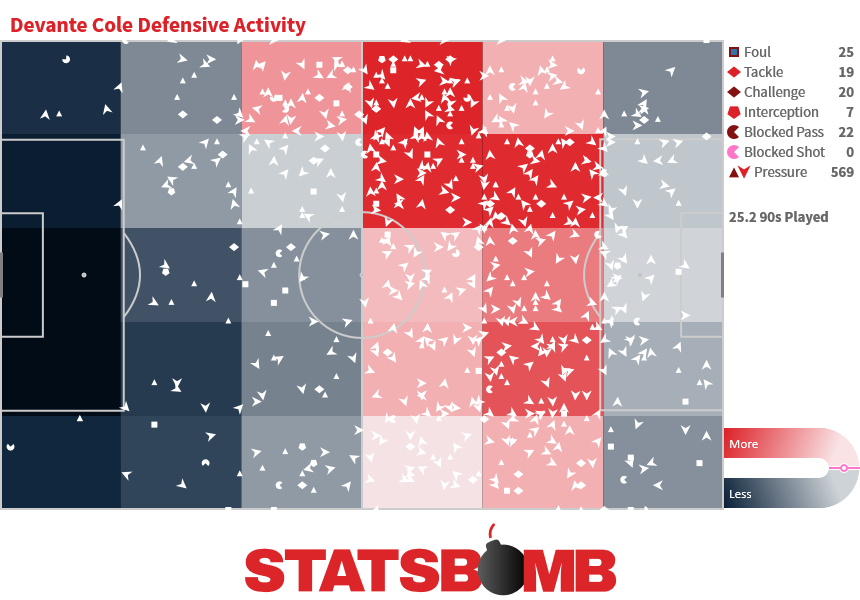 Exactly the kind of profile that might attract a team oriented towards opposition half pressing like Wigan... who promptly signed him in the January transfer window. Sadly for Cole, he only managed six all too brief substitute appearances for the champions in the second half of the season, but we can at least understand part of the thinking behind his signing--beyond the 10 goals he scored for Fleetwood. Expected Goals Lastly, a quick note about expected goals in the division. StatsBomb Data comes with expected goals values for each shot as part of the package so full player and team analysis can be conducted straight away using the benefit of our extensive knowledge in this area. There is occasionally talk that expected goals is a less reliable indicator in non-top divisions. However, using the StatsBomb xG model, we found that there were few surprises at the top of the League One table in 2017-18. The three teams most impressive via expected goals finished first, second and fourth and all ended up being promoted:
Exactly the kind of profile that might attract a team oriented towards opposition half pressing like Wigan... who promptly signed him in the January transfer window. Sadly for Cole, he only managed six all too brief substitute appearances for the champions in the second half of the season, but we can at least understand part of the thinking behind his signing--beyond the 10 goals he scored for Fleetwood. Expected Goals Lastly, a quick note about expected goals in the division. StatsBomb Data comes with expected goals values for each shot as part of the package so full player and team analysis can be conducted straight away using the benefit of our extensive knowledge in this area. There is occasionally talk that expected goals is a less reliable indicator in non-top divisions. However, using the StatsBomb xG model, we found that there were few surprises at the top of the League One table in 2017-18. The three teams most impressive via expected goals finished first, second and fourth and all ended up being promoted: 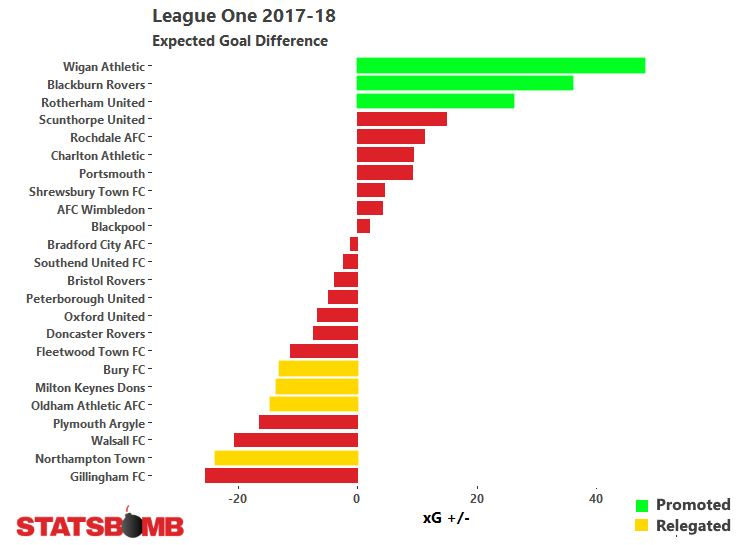 At the bottom of the table, four of the seven lowest ranked teams found themselves relegated, and perhaps Gillingham can consider themselves the biggest beneficiaries of a positive skew in their numbers. By landing 56 points they ended up two wins clear of the drop, yet in doing so overshot expectation by the greatest margin in the whole league:
At the bottom of the table, four of the seven lowest ranked teams found themselves relegated, and perhaps Gillingham can consider themselves the biggest beneficiaries of a positive skew in their numbers. By landing 56 points they ended up two wins clear of the drop, yet in doing so overshot expectation by the greatest margin in the whole league: 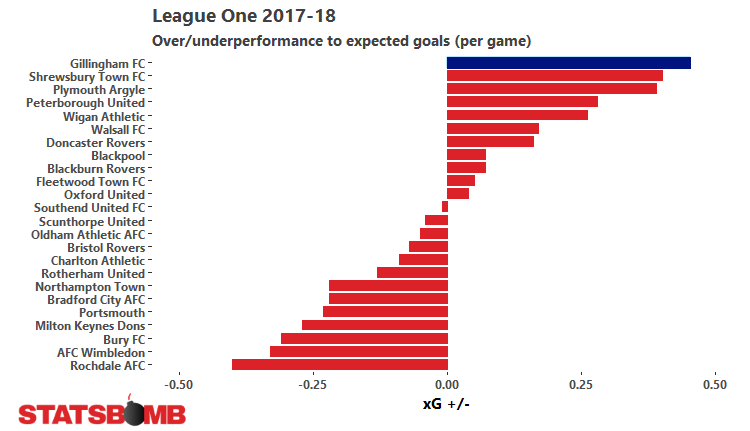 Plymouth were a team who had a season of two halves, 24 points before Christmas and 44 points after and they too look as though they benefited from a positive skew ahead of expectation. For both of these teams expectation ahead of 2018-19 may well need to be tempered, as the structural basis for their final 2017-18 positions indicate possible problems in the future--all things being equal--but it's best to know this ahead of time, rather than be surprised on the other side of any potential reversion.
Plymouth were a team who had a season of two halves, 24 points before Christmas and 44 points after and they too look as though they benefited from a positive skew ahead of expectation. For both of these teams expectation ahead of 2018-19 may well need to be tempered, as the structural basis for their final 2017-18 positions indicate possible problems in the future--all things being equal--but it's best to know this ahead of time, rather than be surprised on the other side of any potential reversion. 